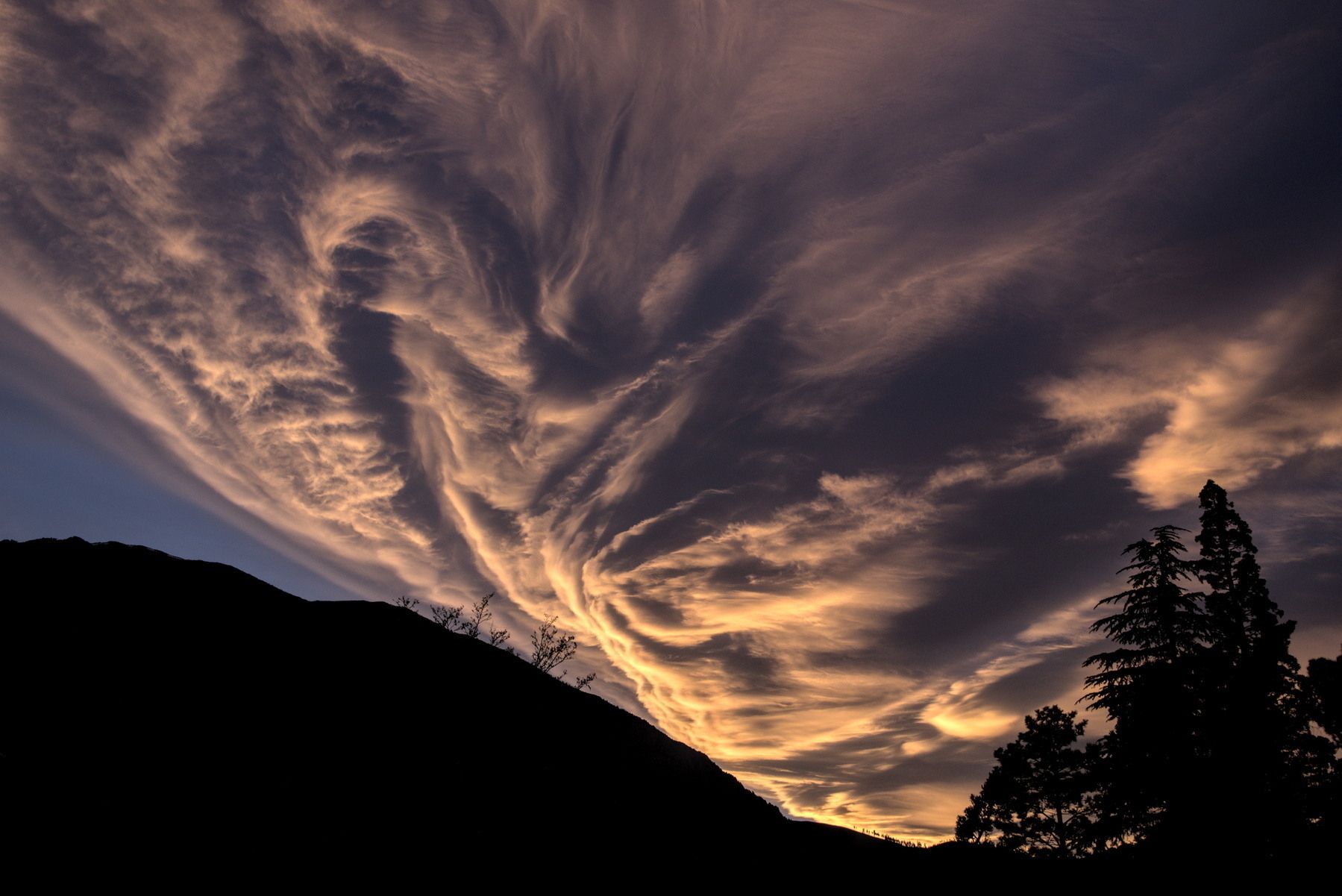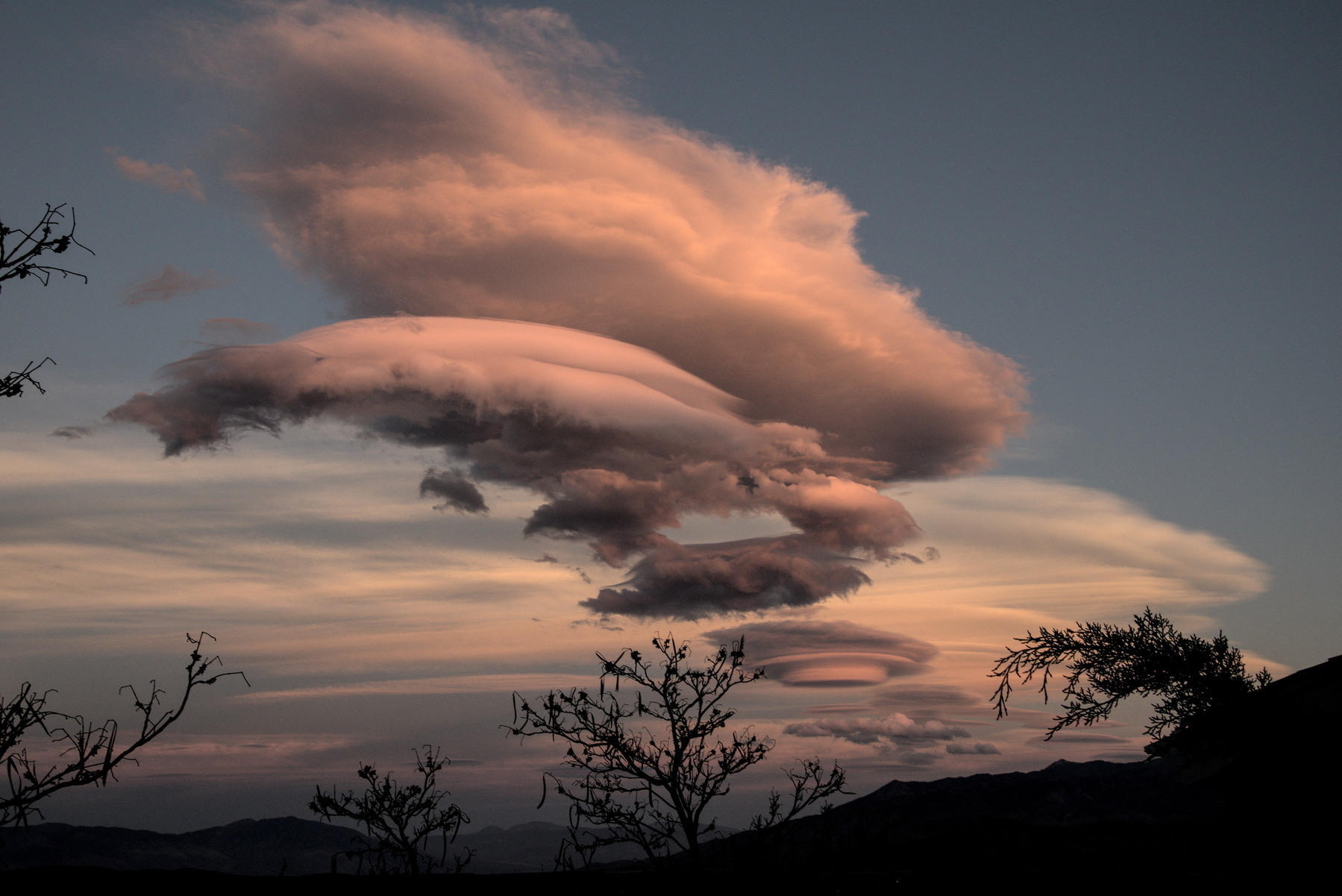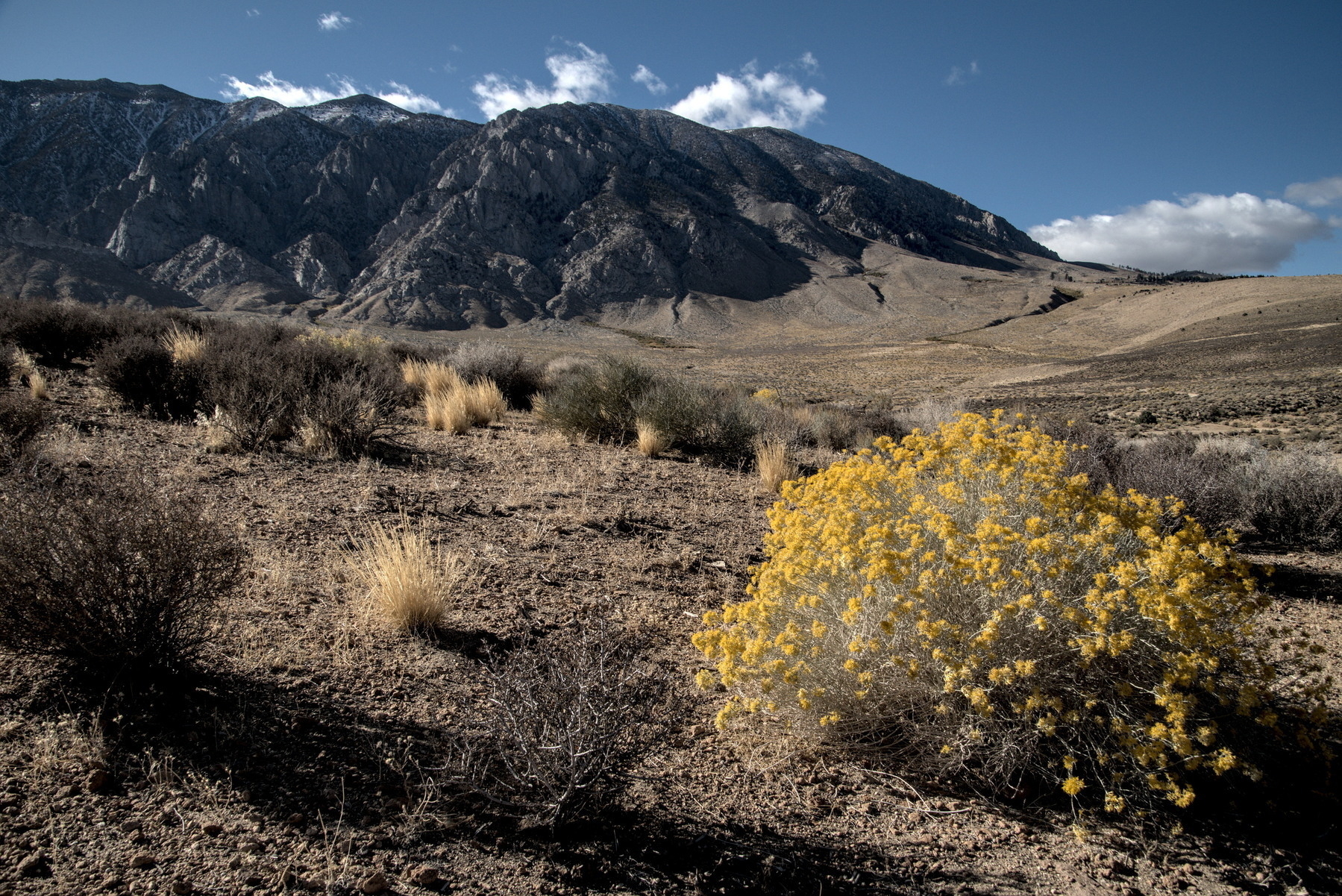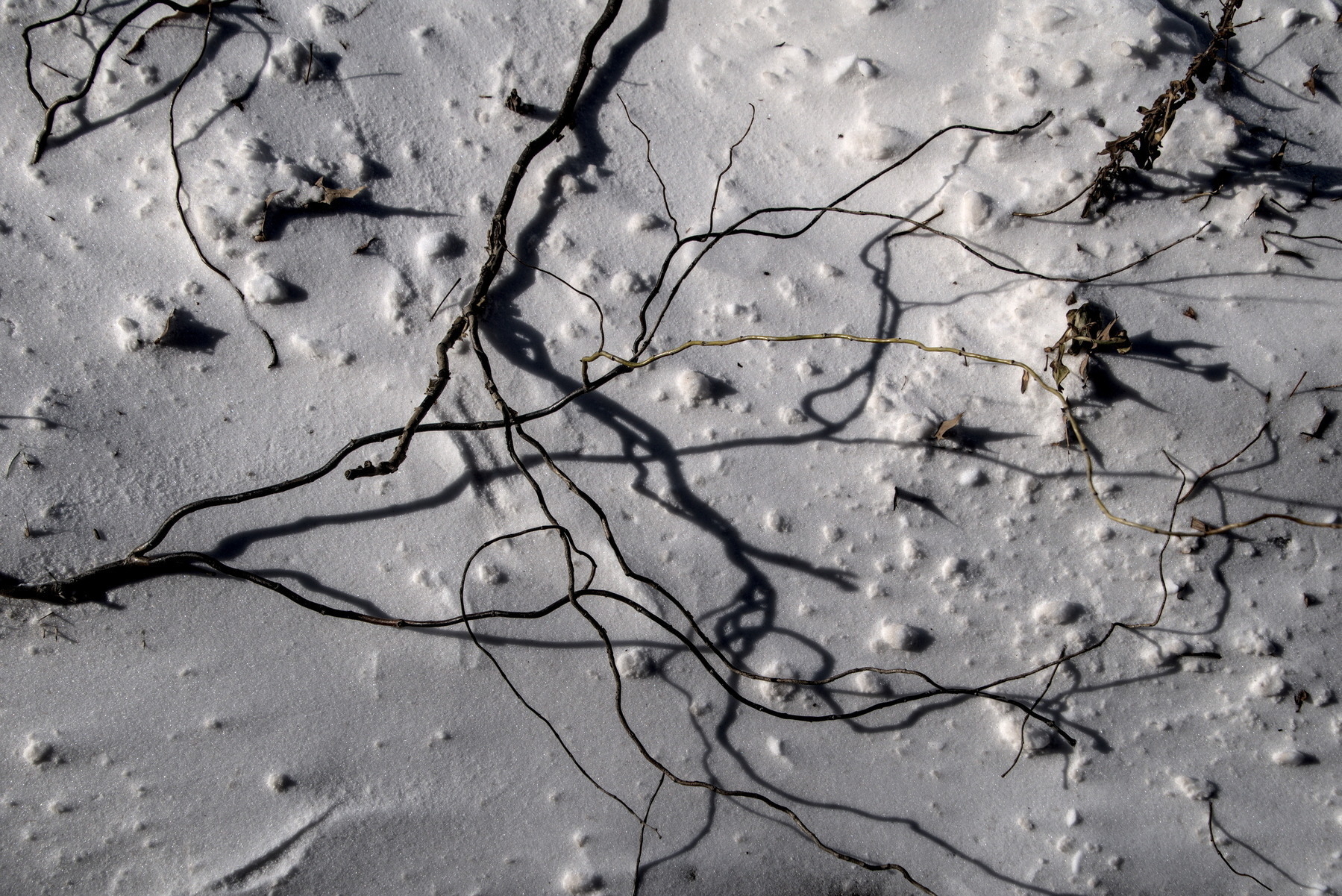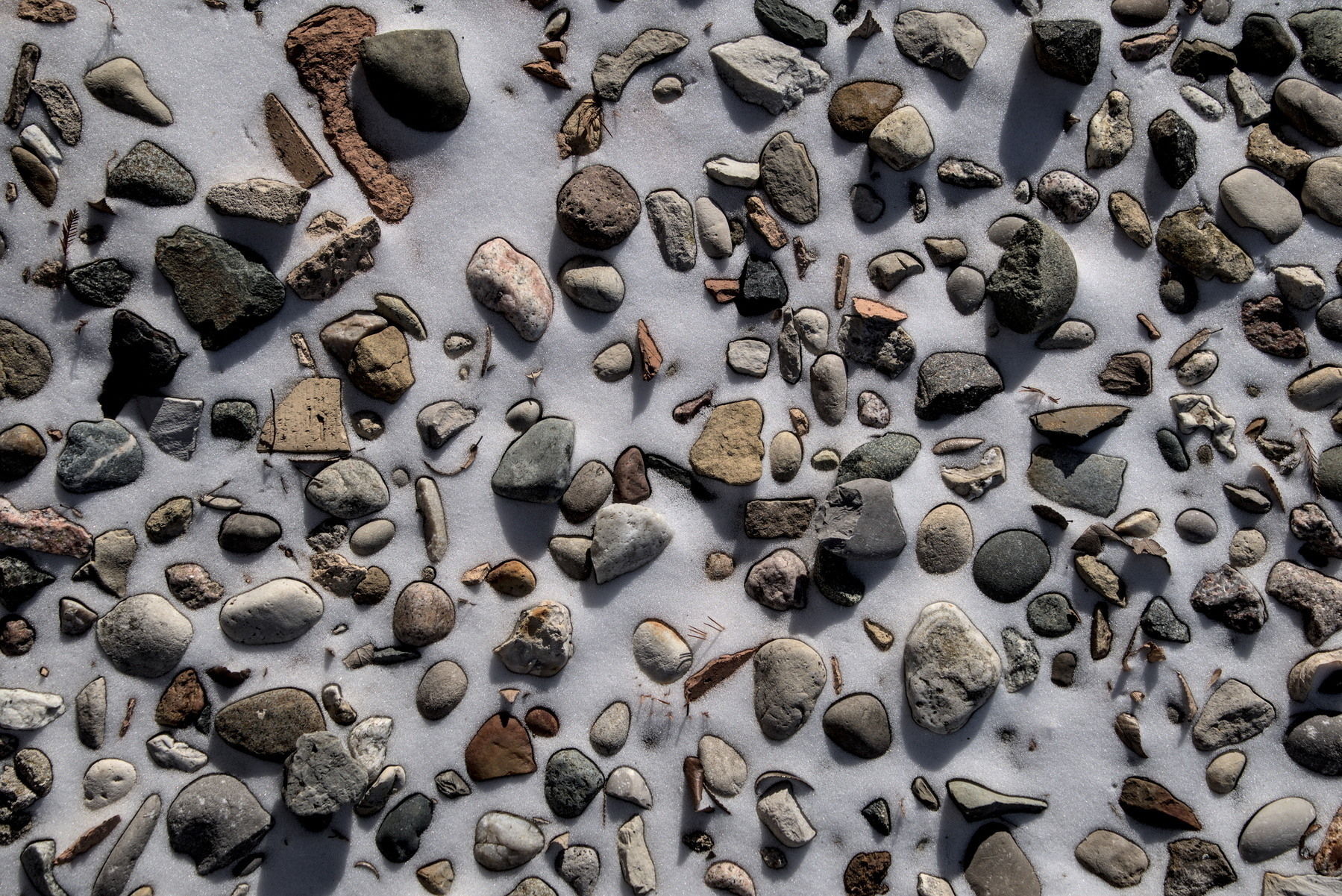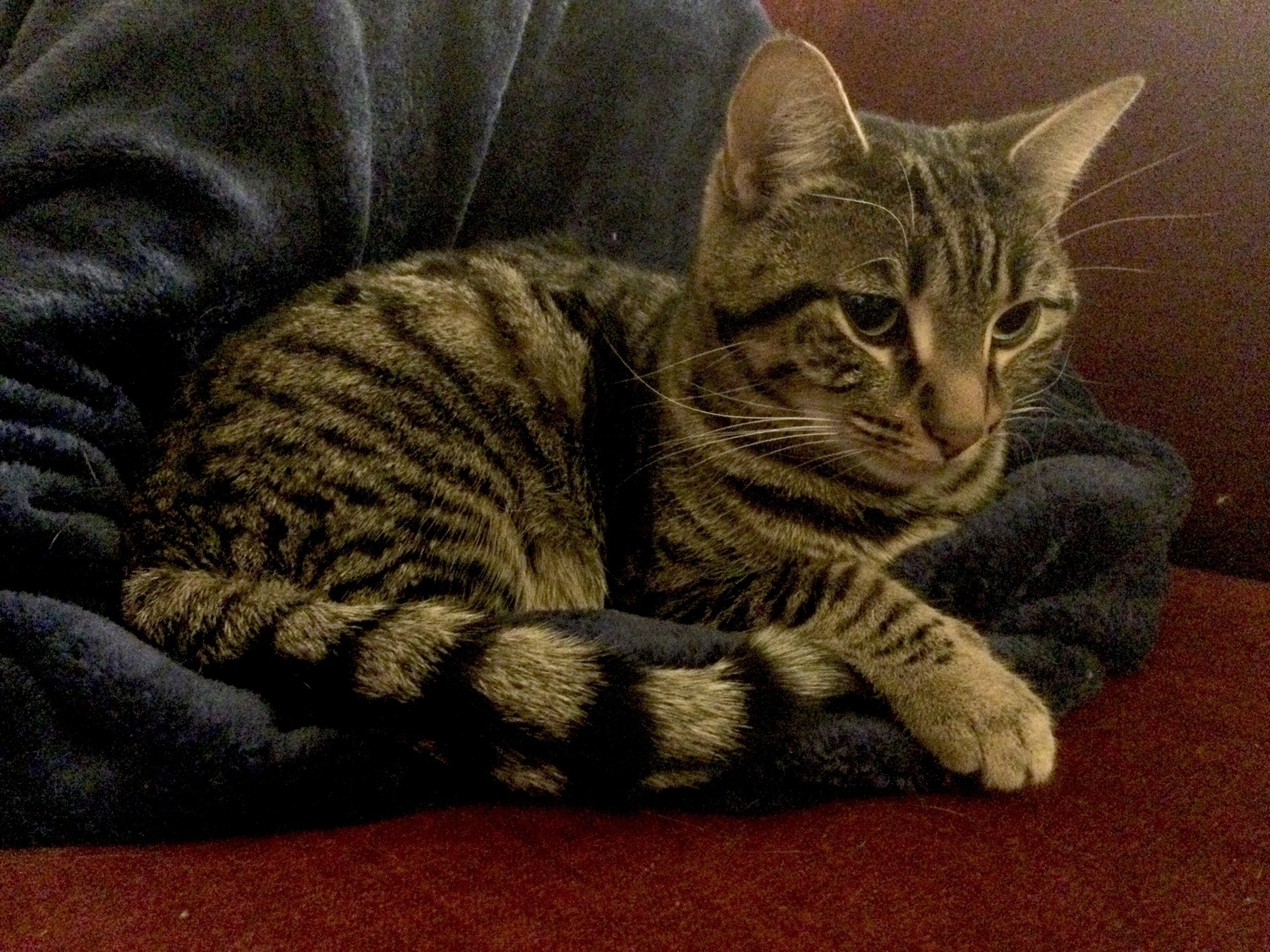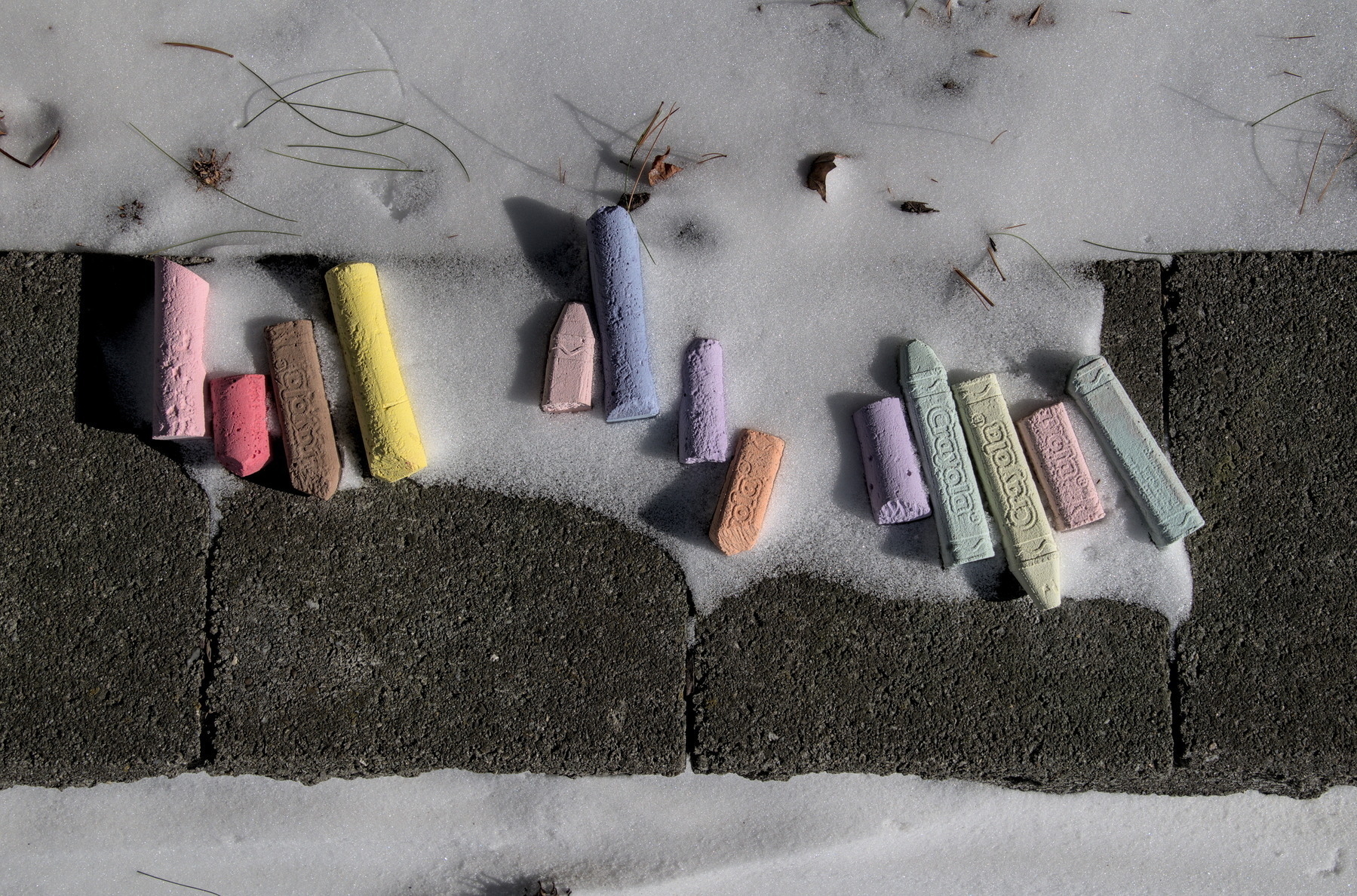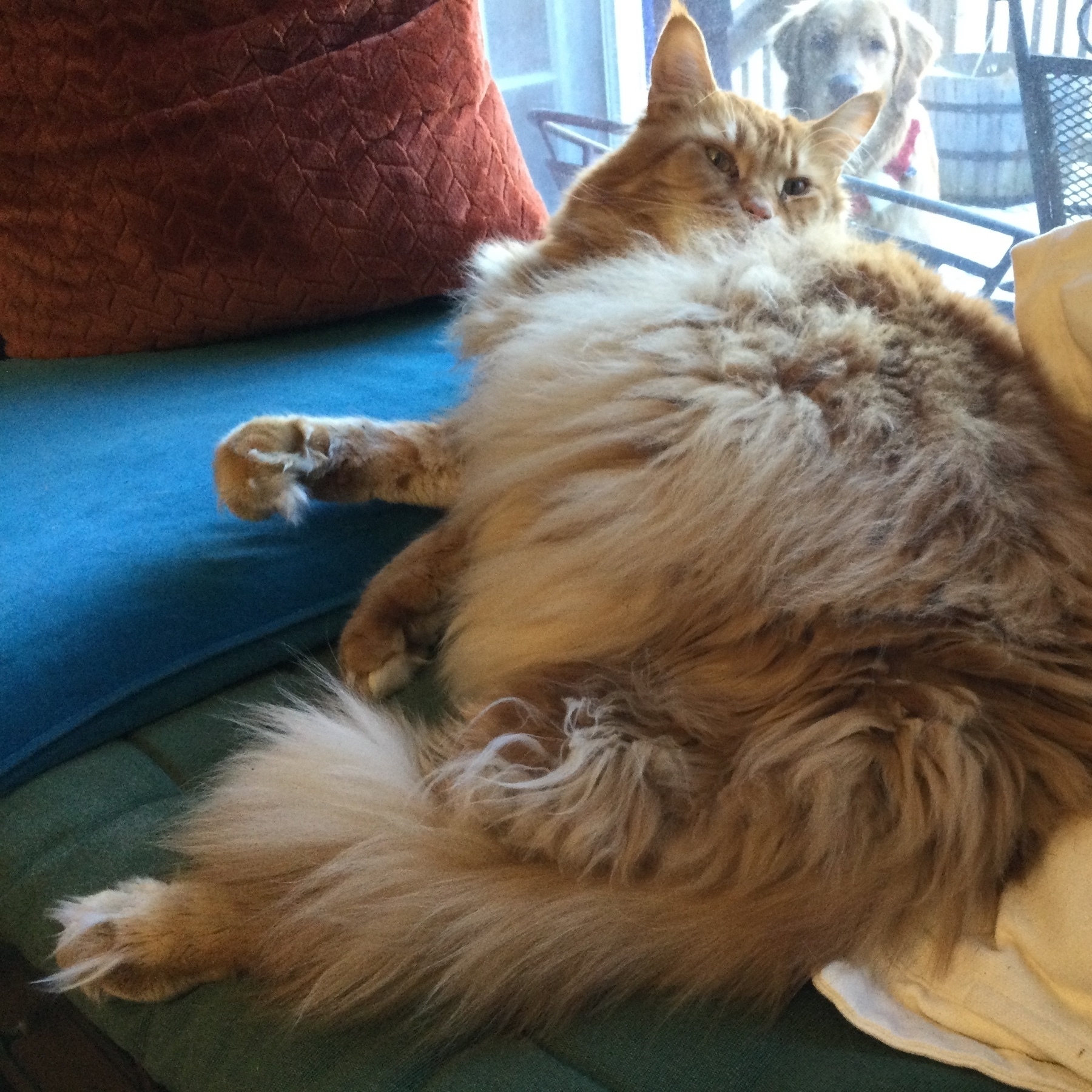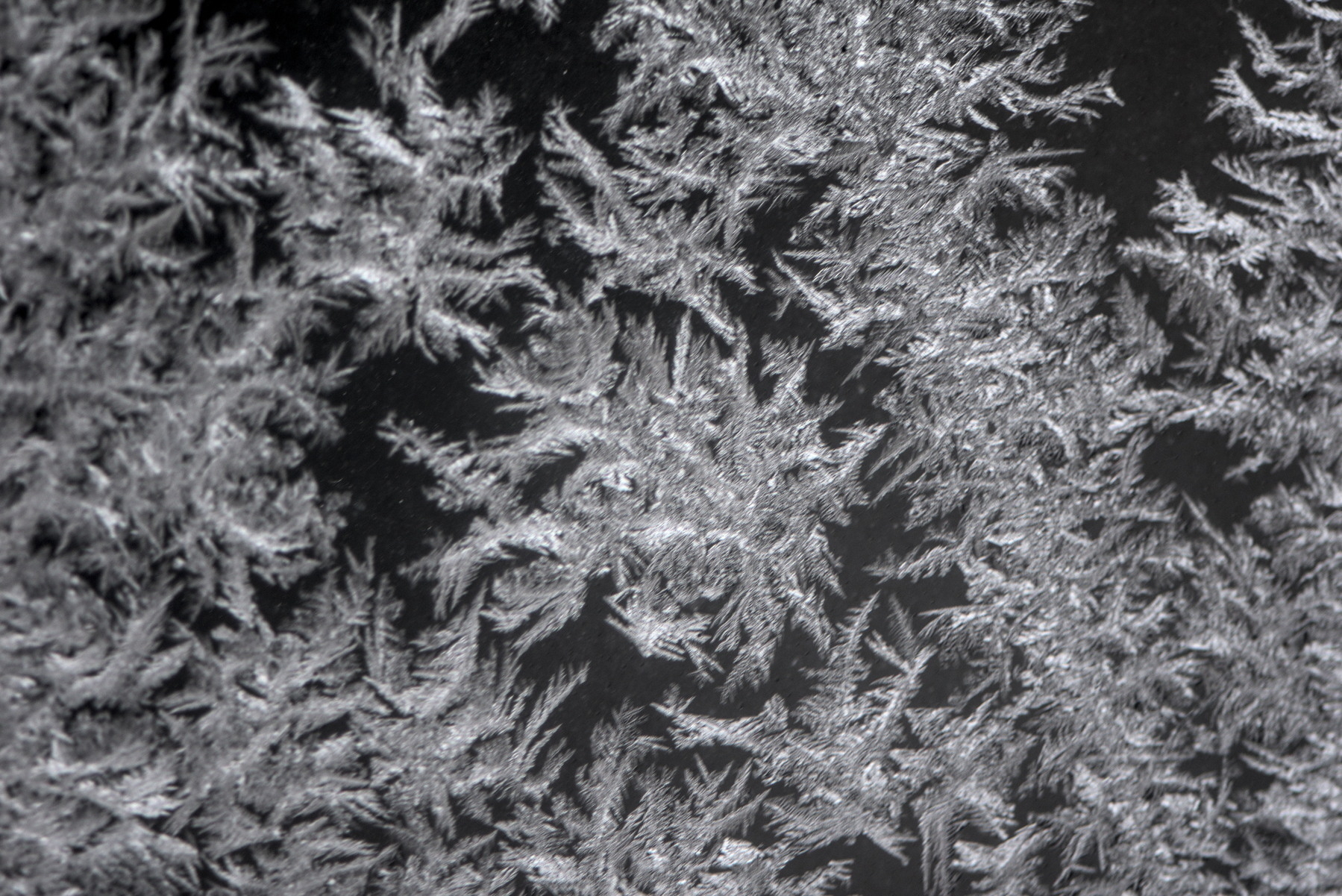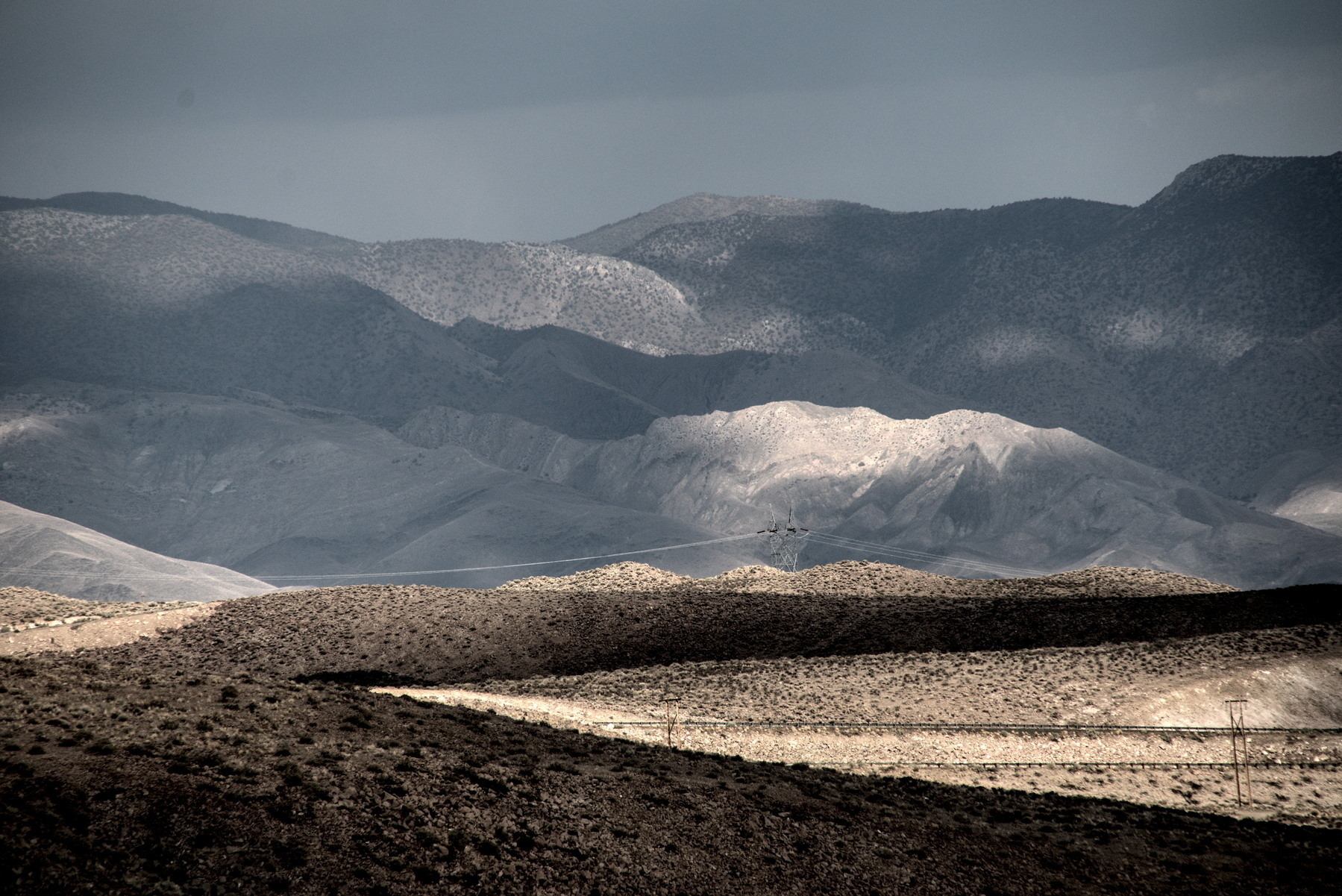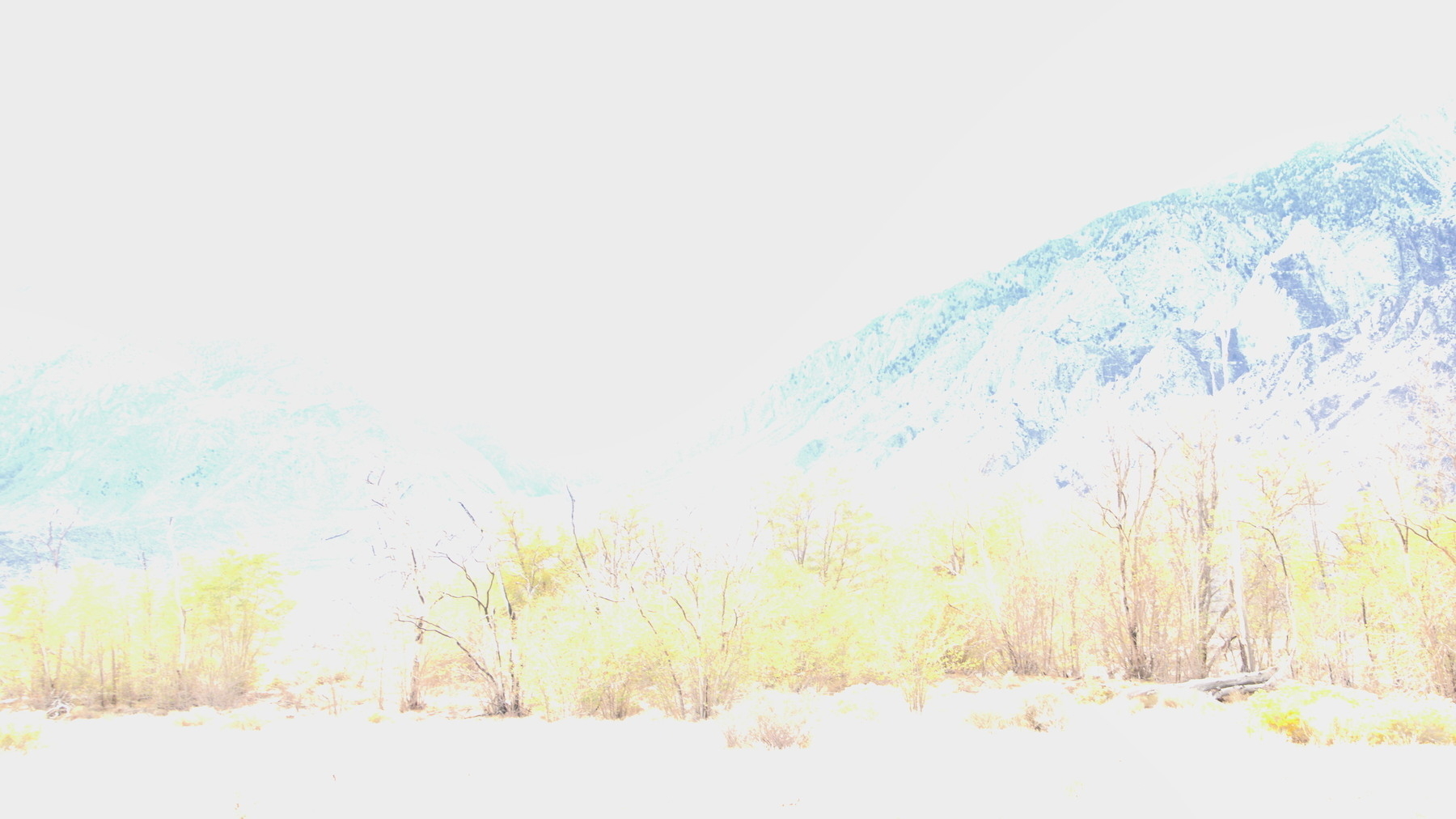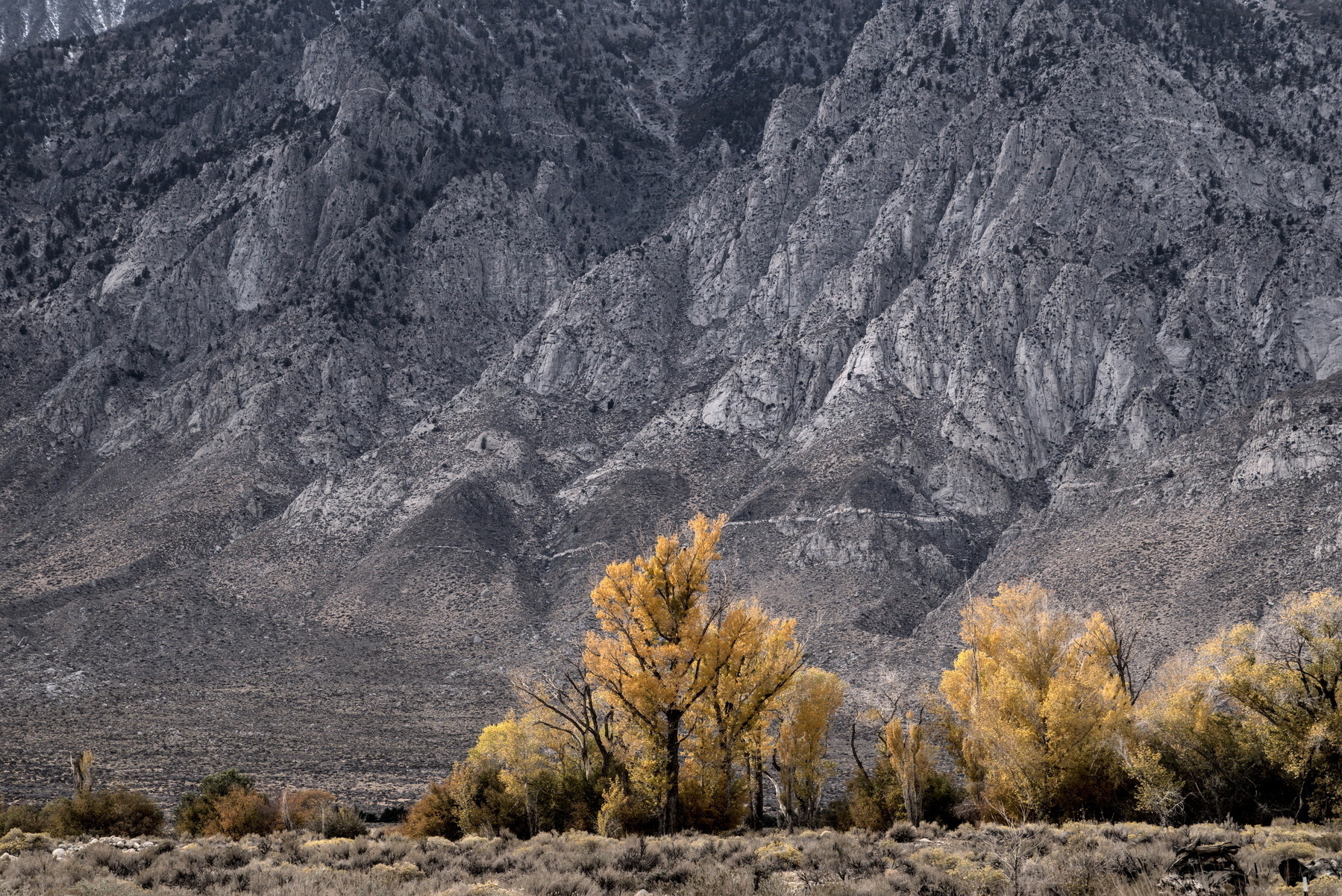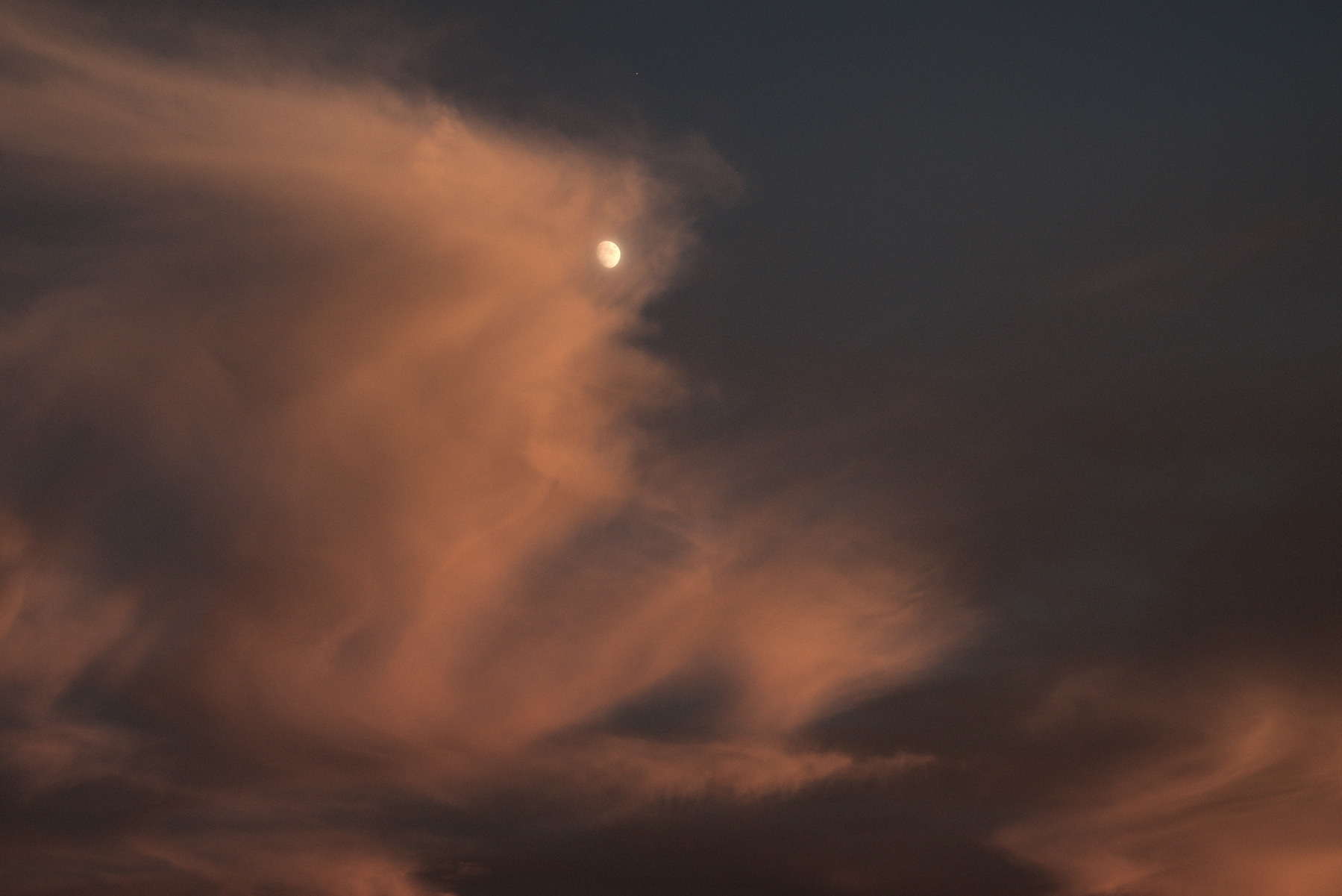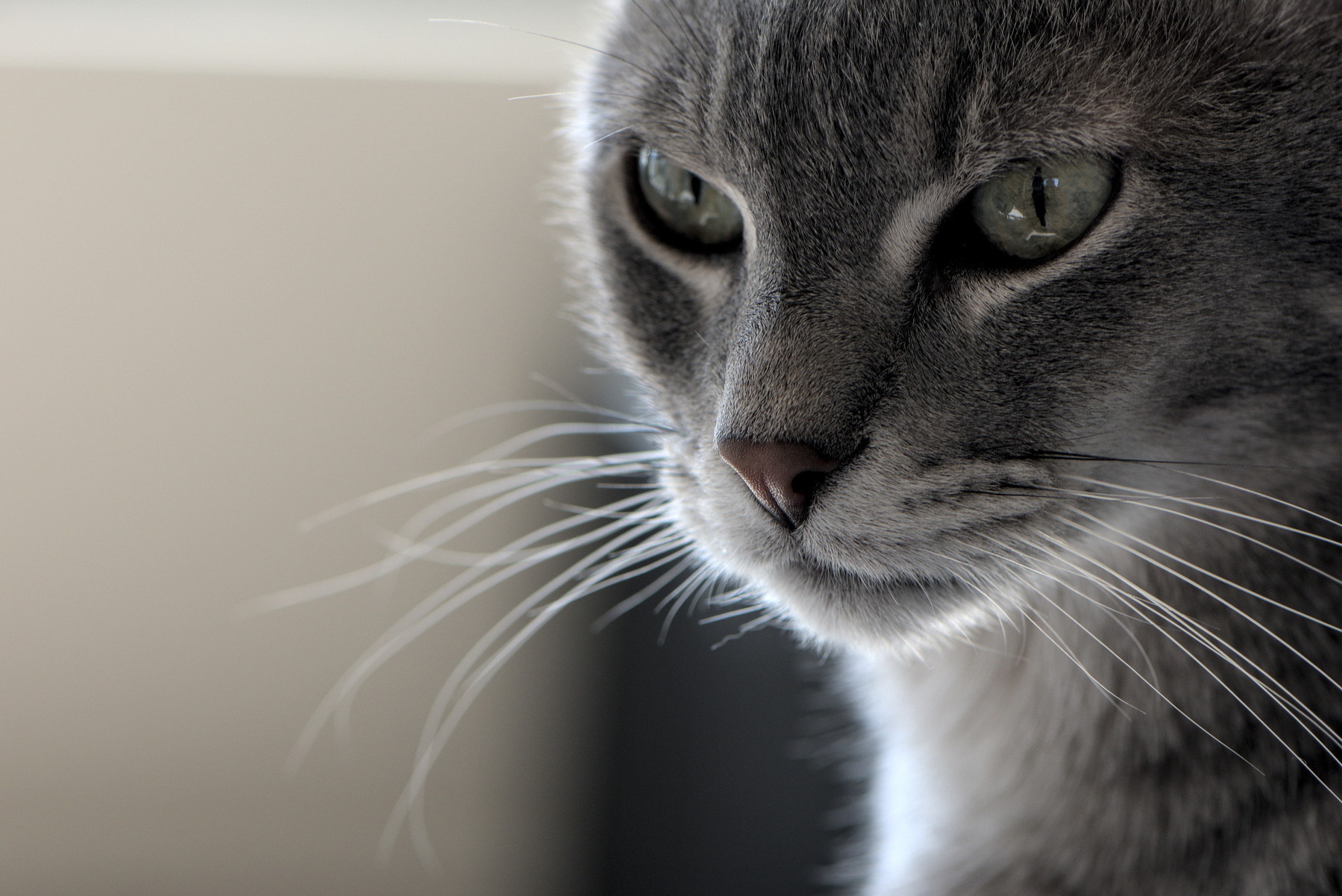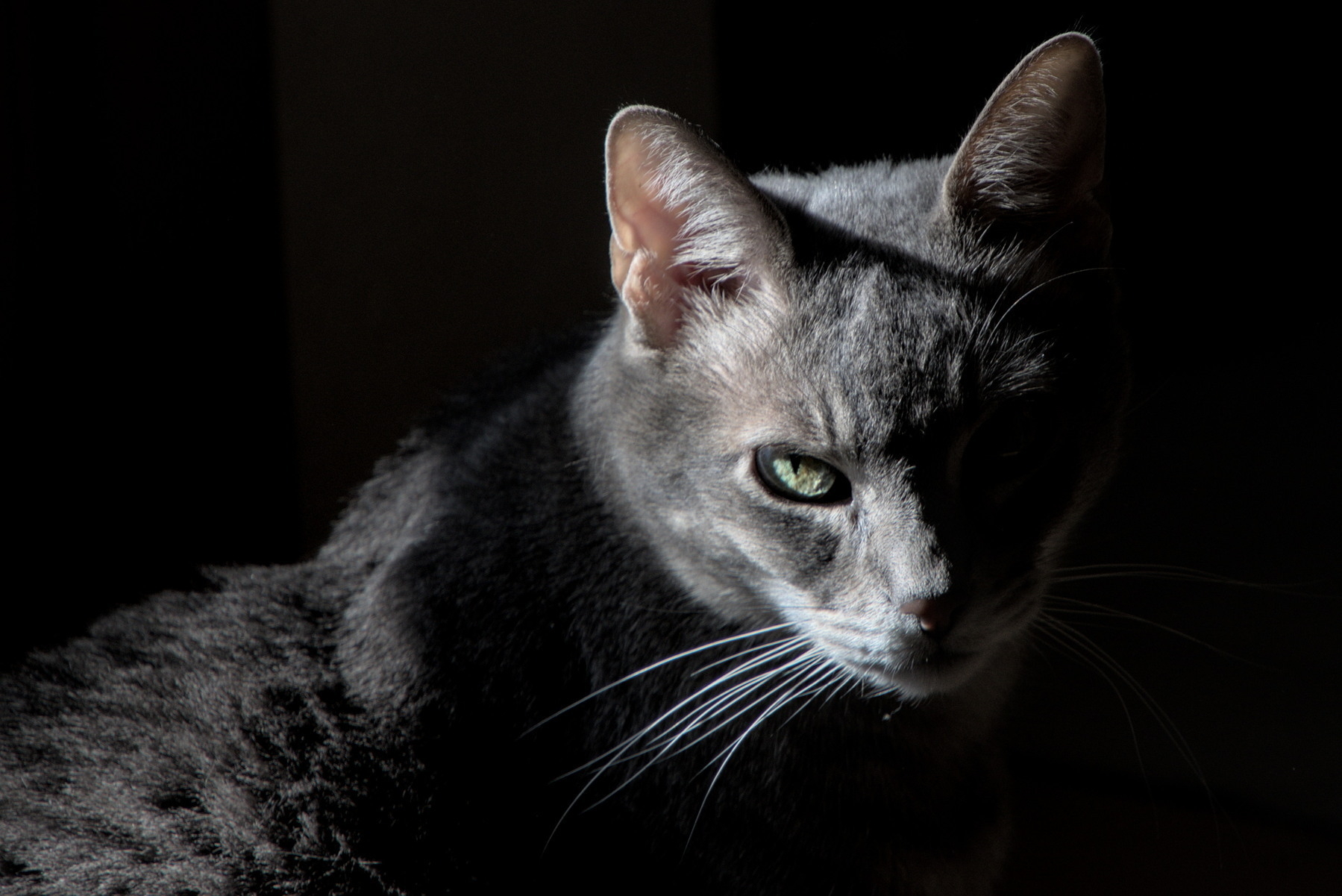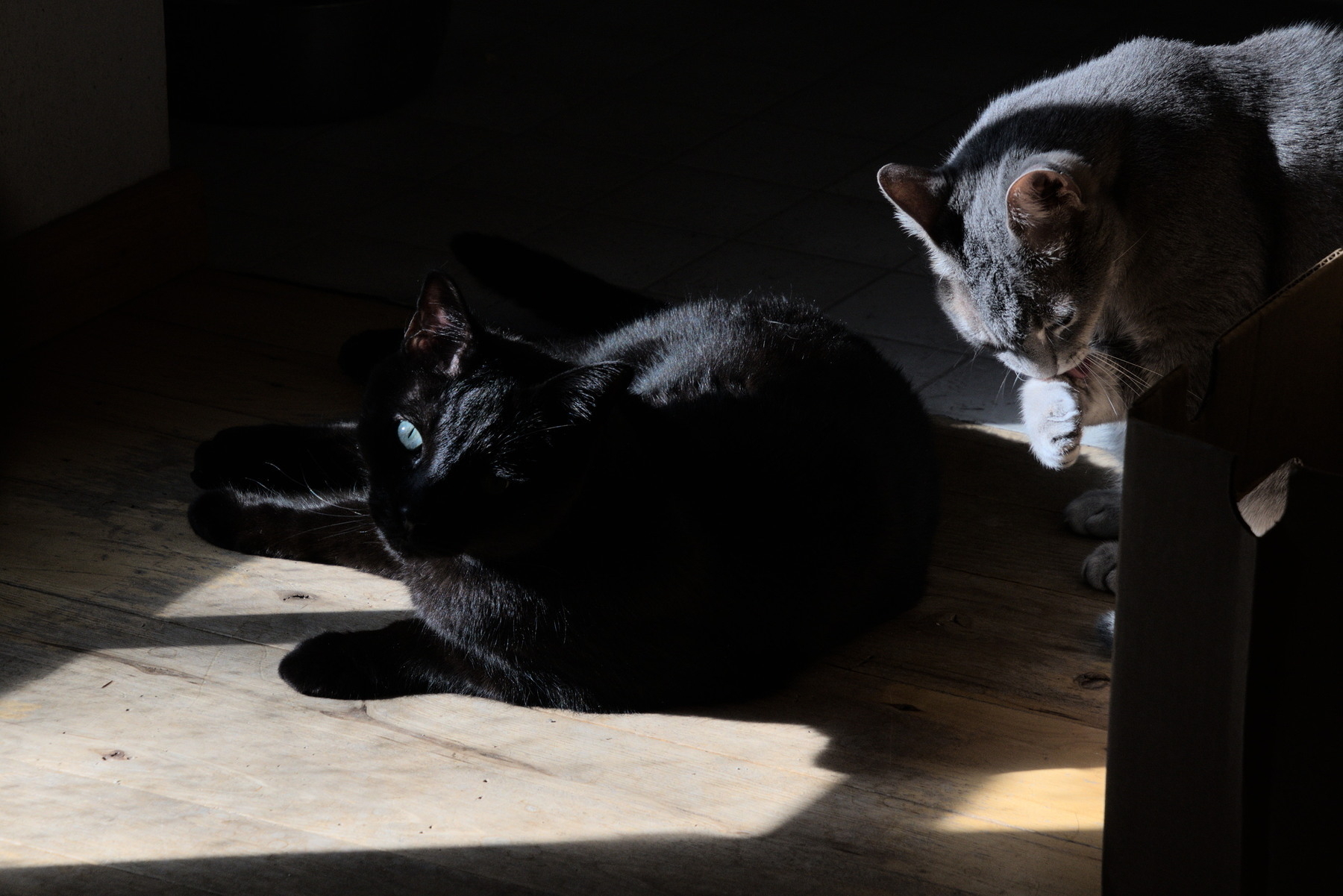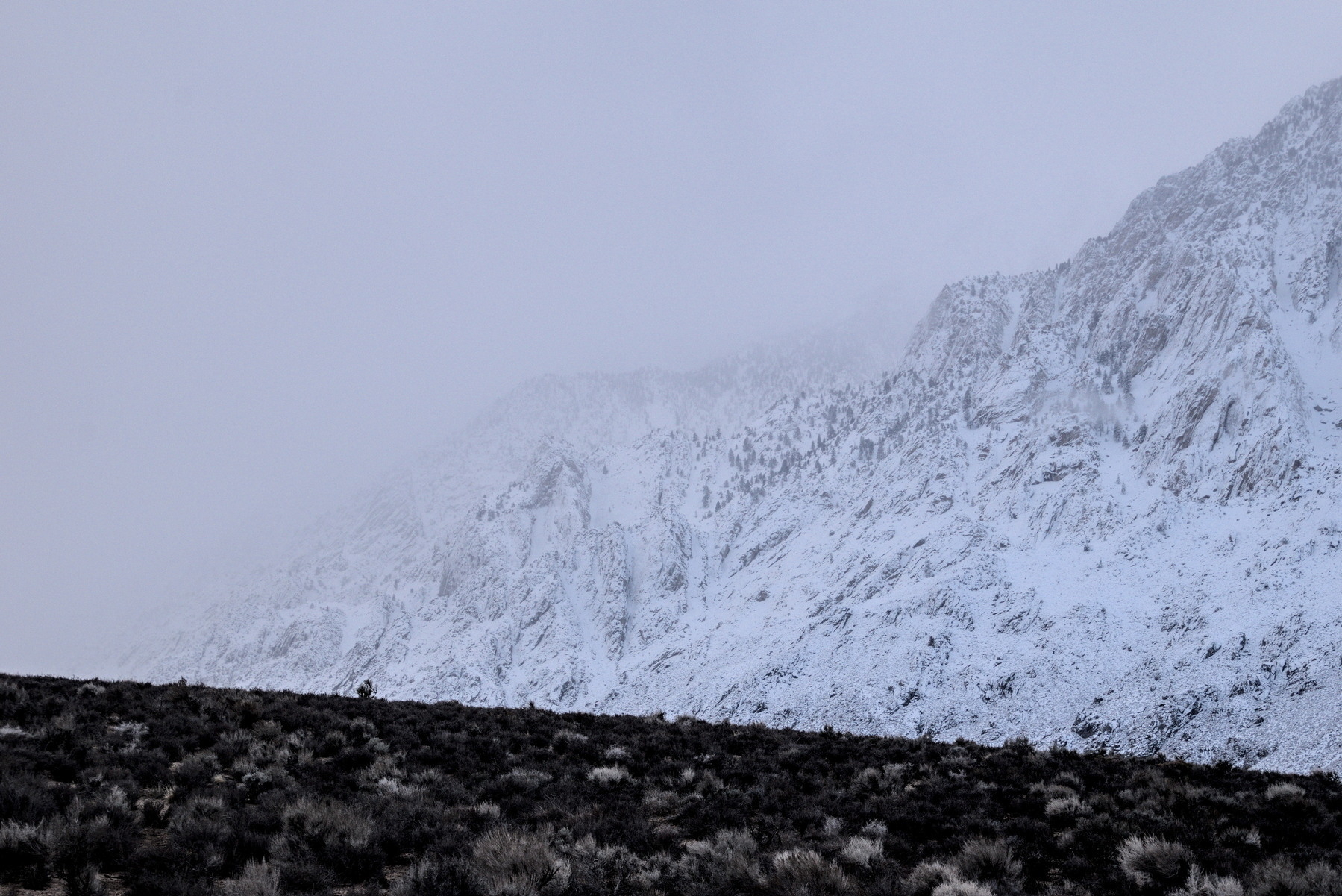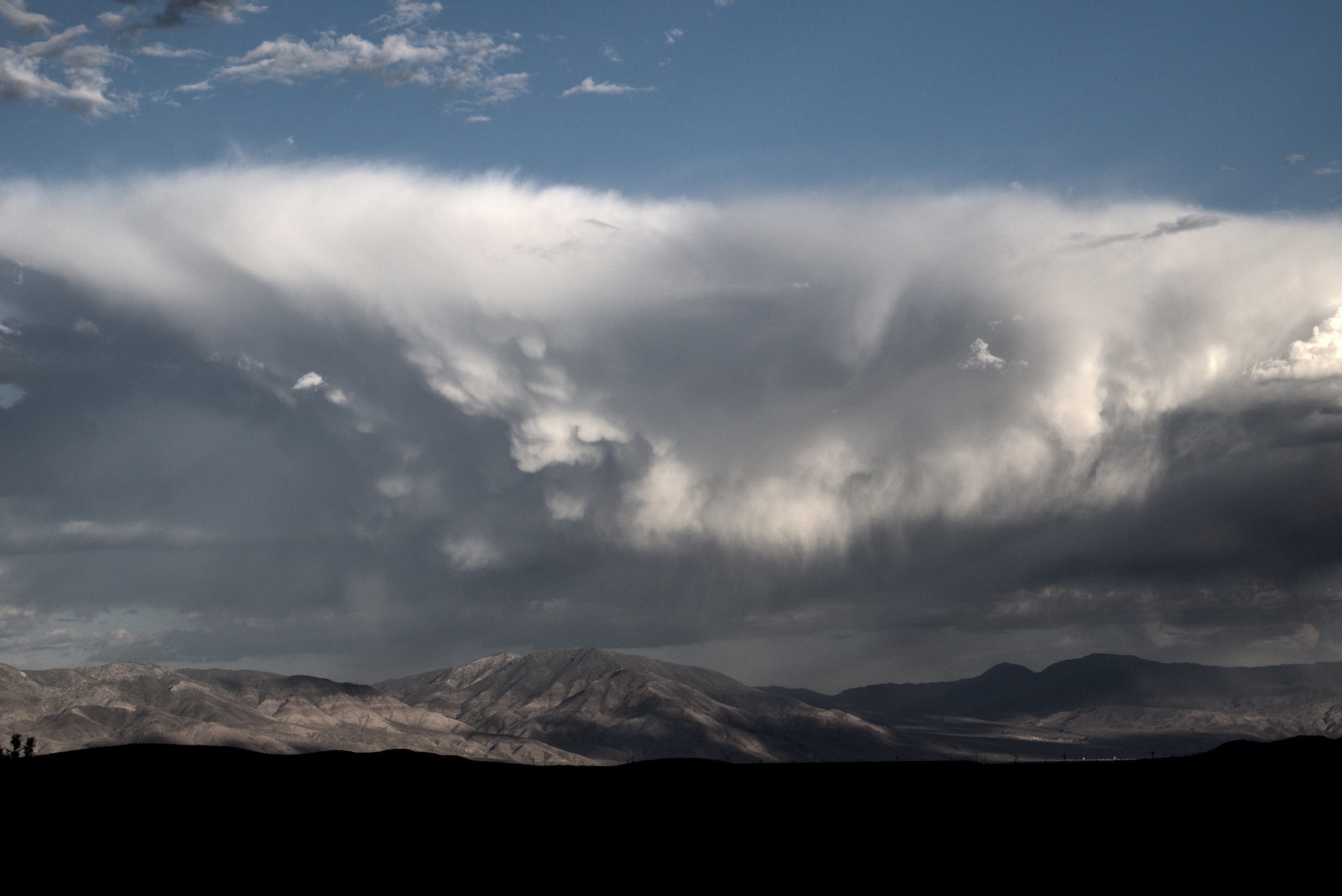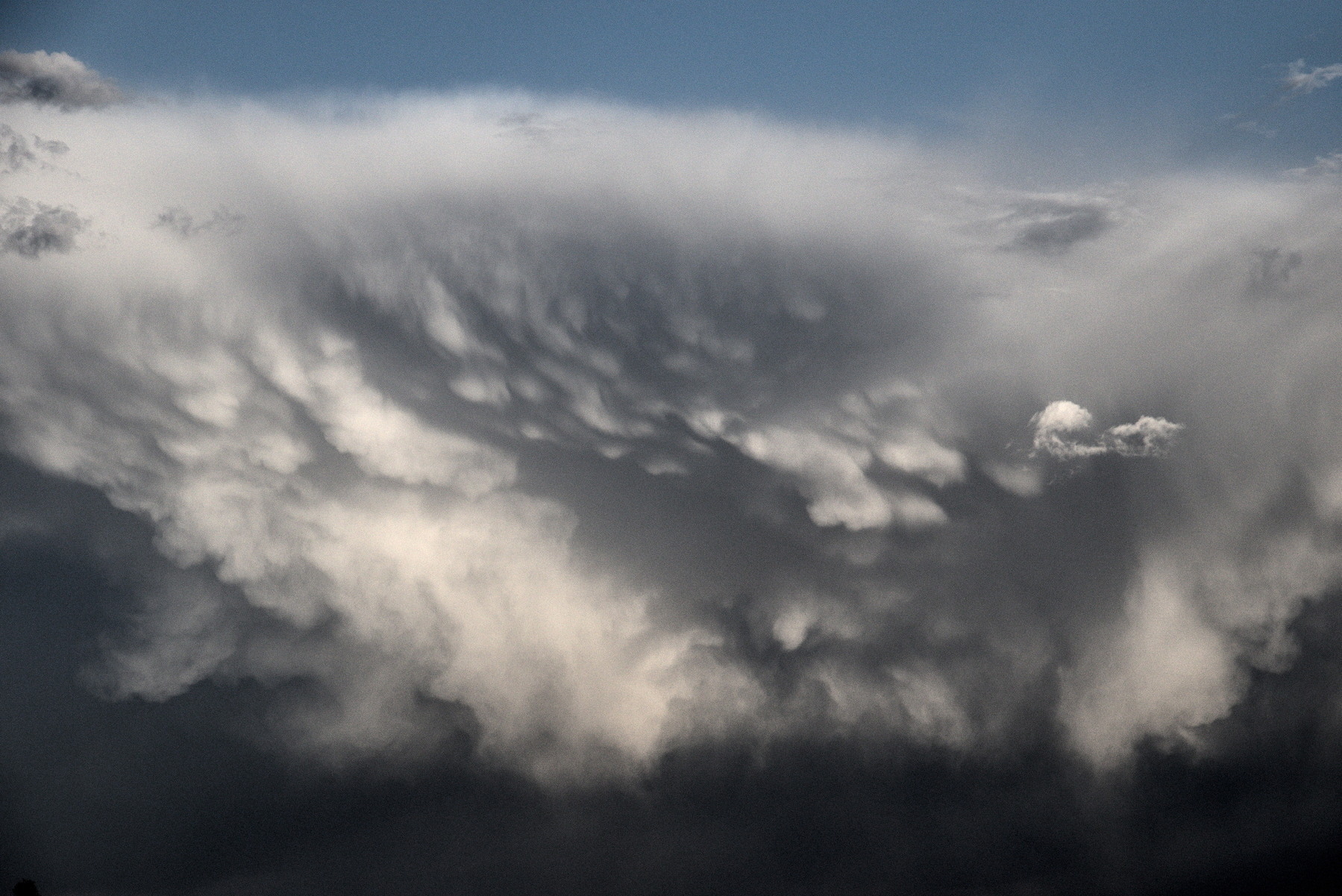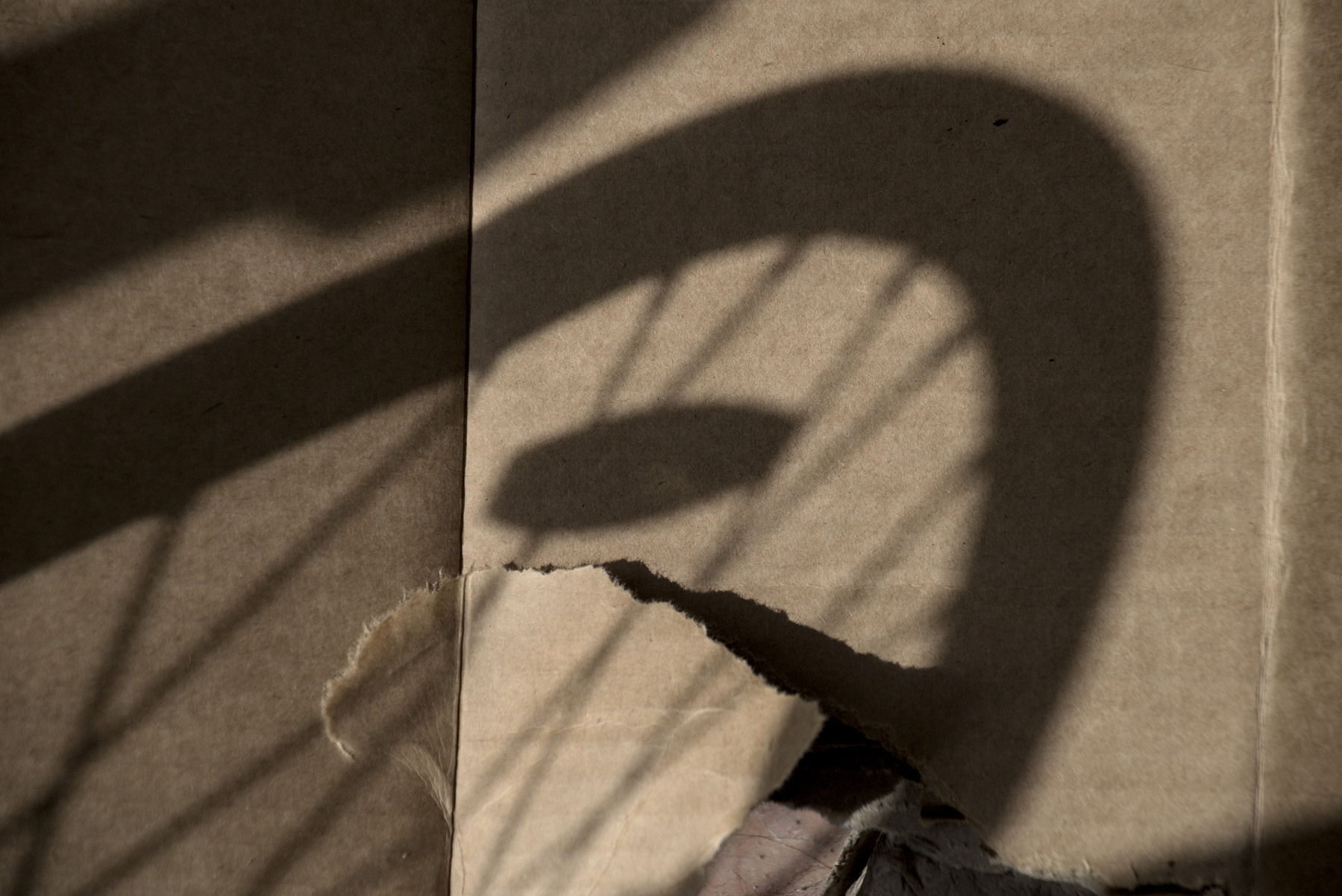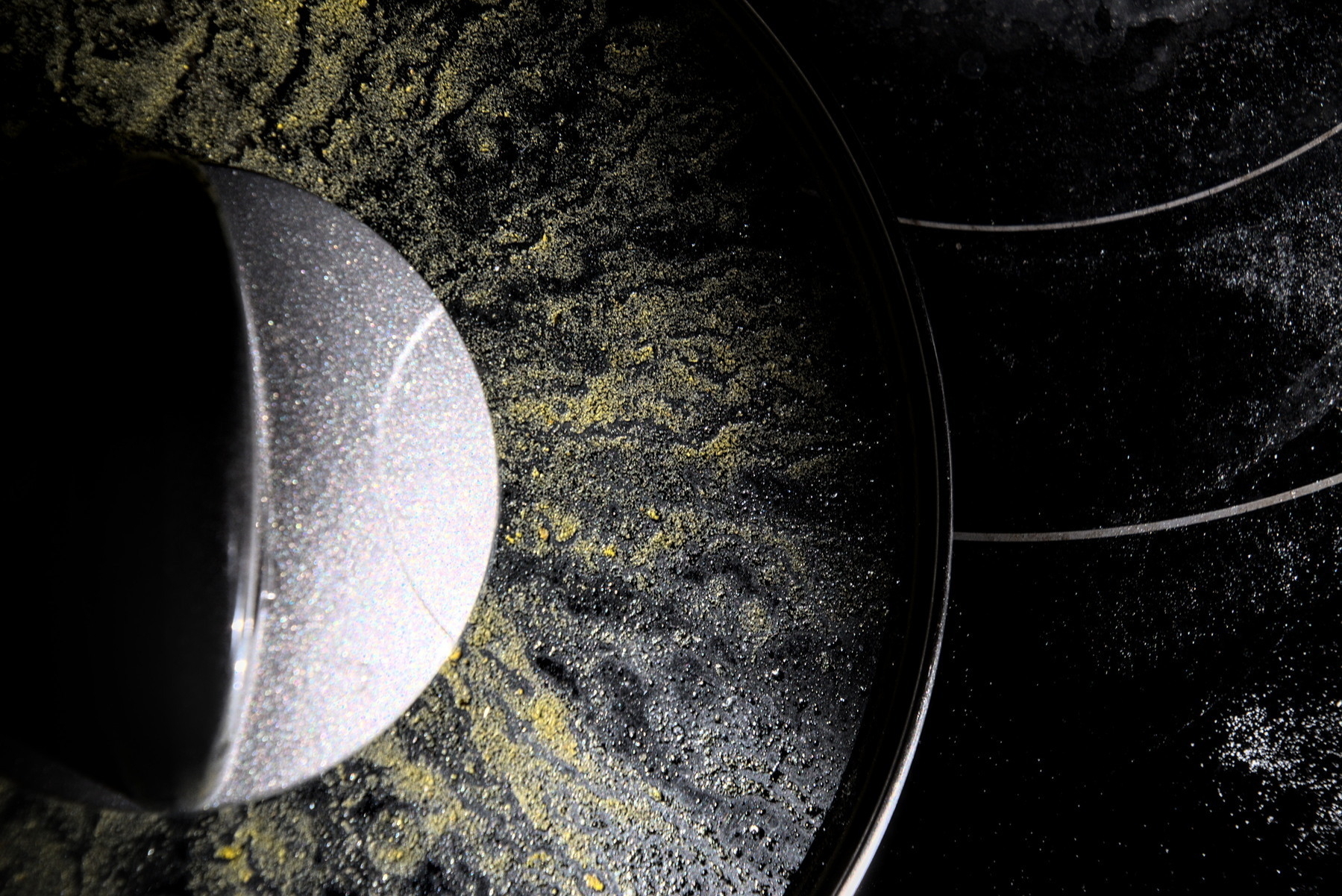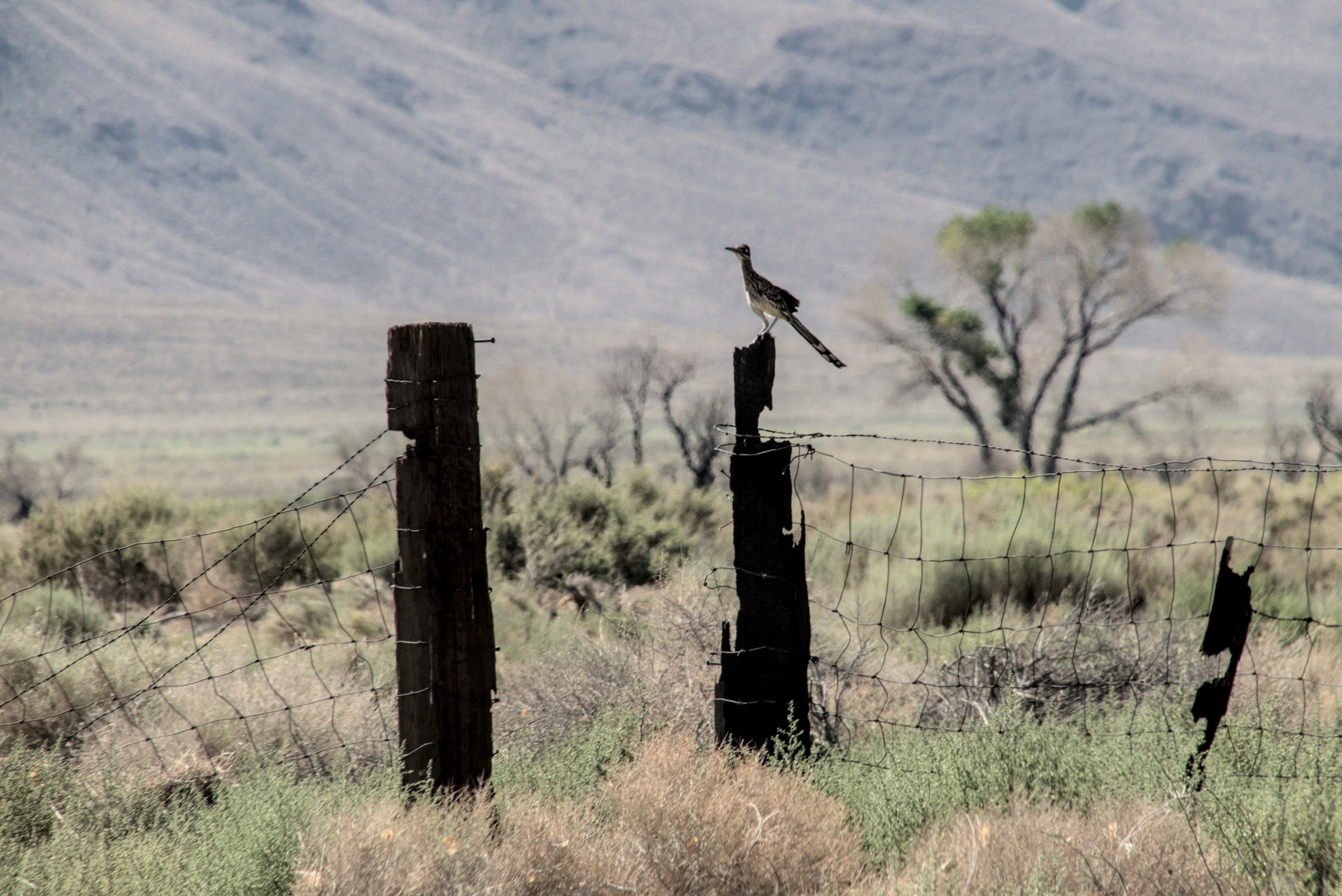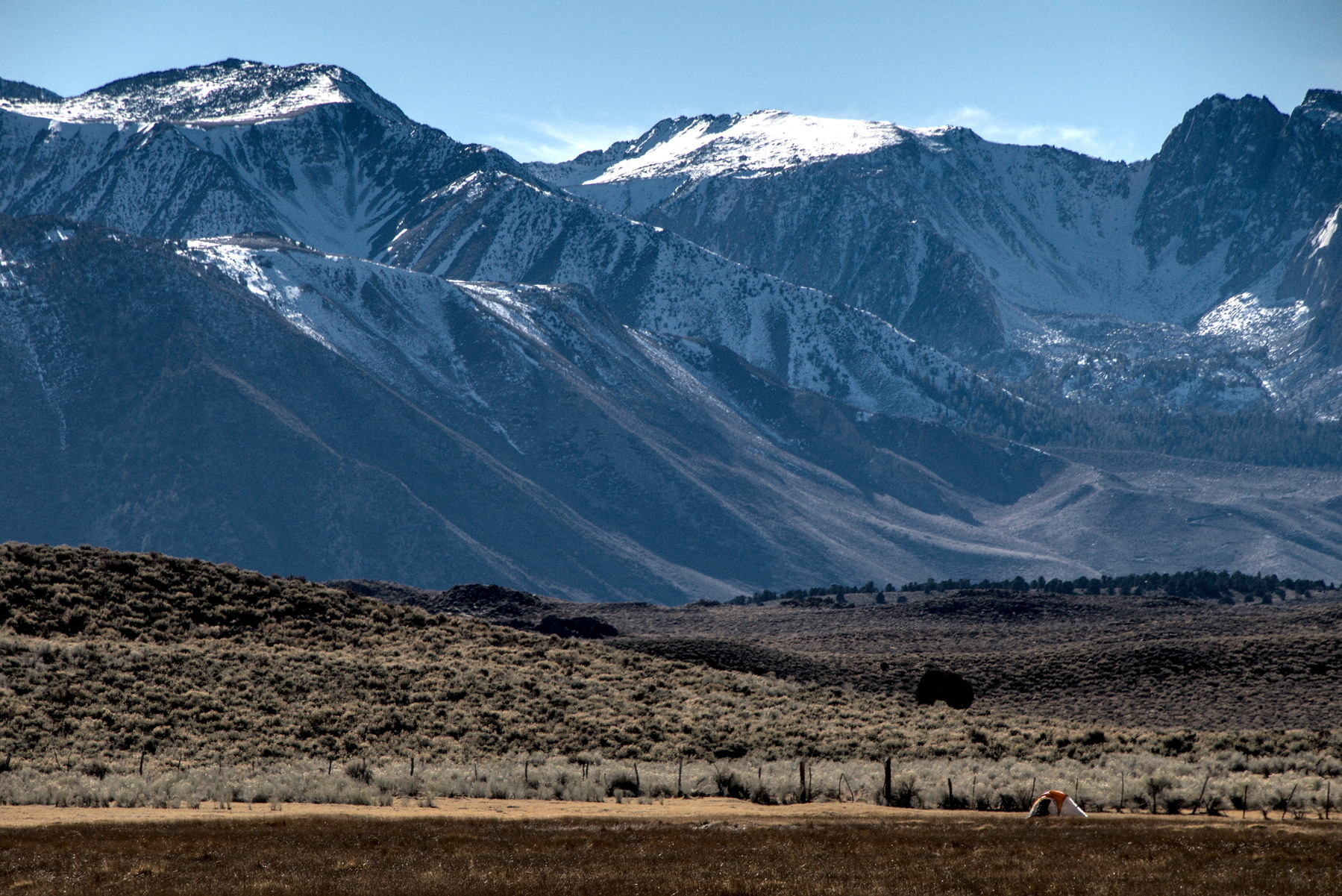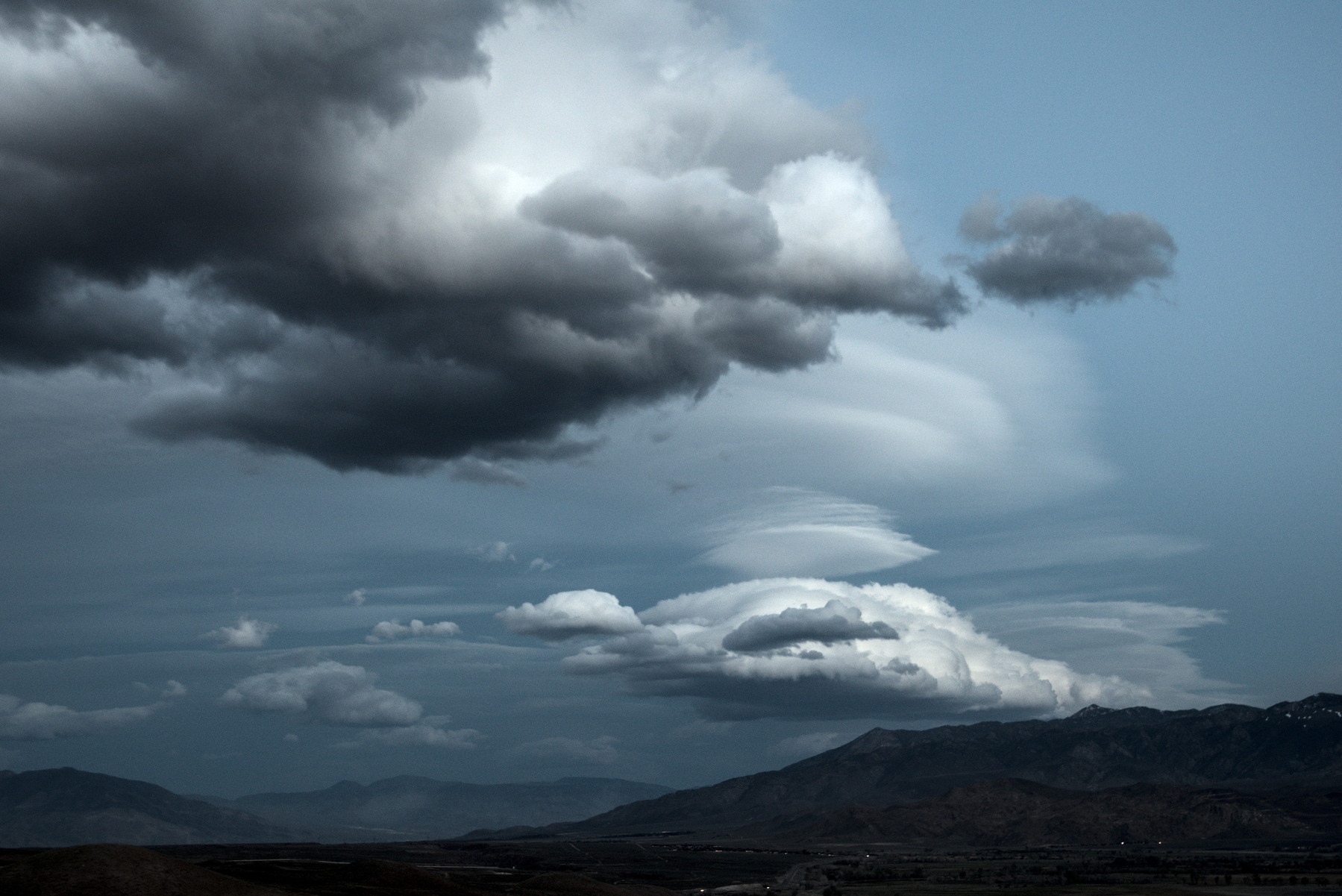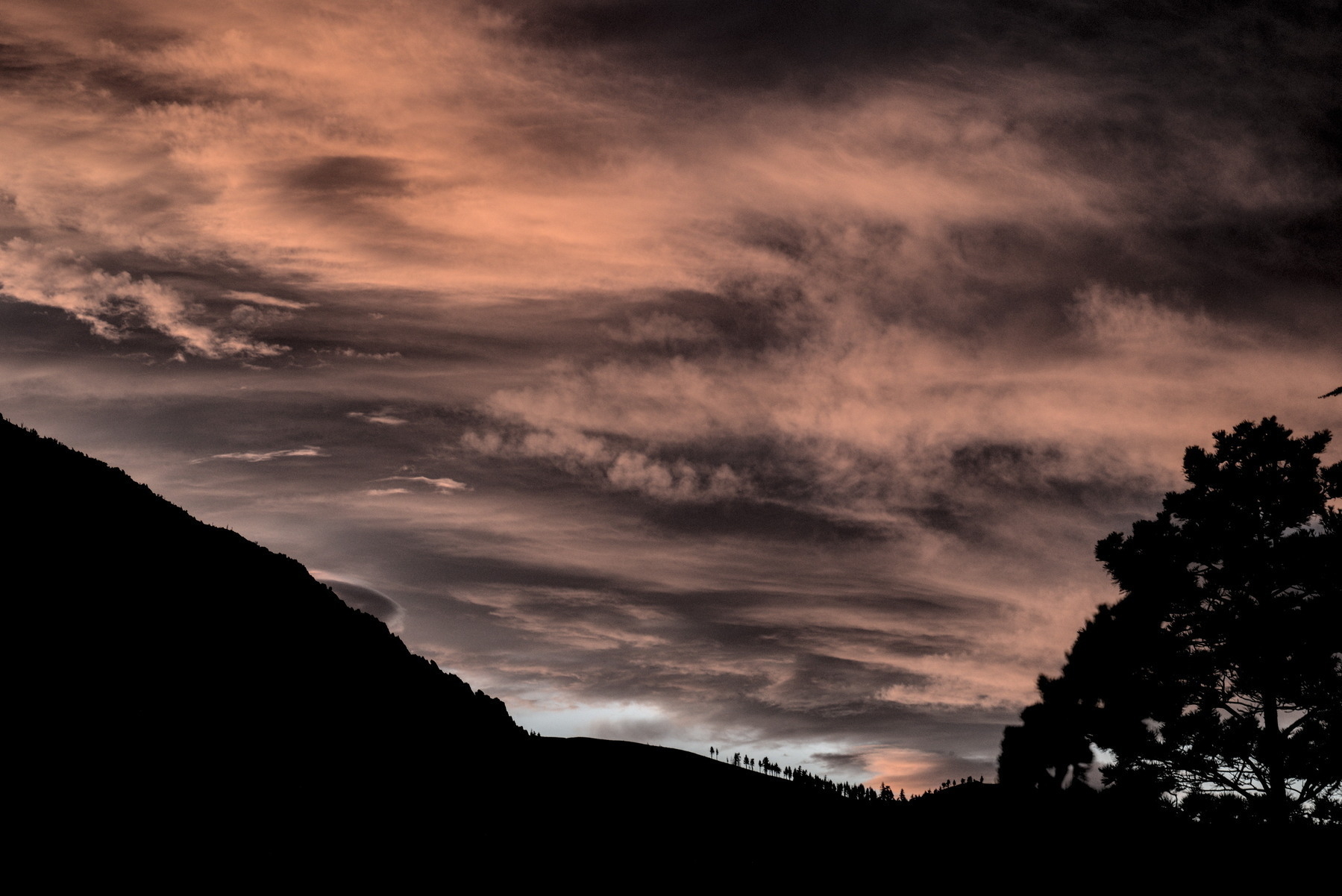-
Remembering the Big Show
I sometimes refer to the cloudscapes here as “the big show”. Everyone sees the quality of light change and goes outside to see what’s up, literally. (Literally “literally”, not “OMG!” literally.) This is what we found one day in May of this year.
But today’s big show is the year gone by, and I find myself singing “Across the Great Divide”, by Kate Wolf.
I've been walkin' in my sleep Countin' troubles 'stead of counting sheep
I don’t really know Kate Wolf’s performance, but Nanci Griffith’s from her amazing album, “Other Voices, Other Rooms.” So it’s Nanci’s voice I’m singing along with in my head. The first thing that surfaces is sadness, remembering her death during the pandemic, and the stories that surfaced about her frustrations at not making it to the big time.
Where the years went I can't say I just turned around and they've gone away
This past week I’ve been visiting family. My father is 94, hanging on, but has lost a step or three. It’s always good to see him, but the experience is counter-weighted by his loss of mental acuity and the difficulties of caring for him, though that mostly consists of worrying about our step-mother, who shoulders the burden. We are grateful for her magnificent efforts, but she is slow to ask for help, and we fear she will run herself into the ground in the process.
I've been siftin' through the layers Dusty books and faded papers
My two brothers and sister-in-law who live here help out as they can, and I’m grateful for their efforts as well. I’ve helped out with heavy lifting, but I find it hard to engage in the care process. So I’ve helped review the paperwork and worried about terms and conditions, provided food and entertainment, and hope I’ve done enough.
They tell a story I used to know And it was one that happened so long ago
And in the quiet moments, I fnd myself swimming in memories, revisiting decisions I’ve made, or, more often, not made, that have changed the flow of my life.
It's gone away in yesterday Now I find myself on the mountainside Where the rivers change direction Across the Great Divide
And I look back at this photo of a cloud like no other I’ve seen, a visual manifestation of immense flow and turbulence, and remember that we can only control so much. We make decisions with too little information and too much bias, and there seems little chance that life will go exactly as we plan. The big show continues regardless of how we choose, and I remind myself to put down my burdens, go outside, and enjoy the sky when it lights up.
-
Clouds at the end
Since it has been such a banner year for clouds, I thought I would close with a few more photos of them.
Does this photo remind you of one I posted earlier in the December retrospective? Does it surprise you that these photos were taken nearly a month apart? If you went down to a creek and saw the same standing waves on different days, would that surprise you? I think this is the most startling thing about lenticular clouds. They form in standing waves shaped by mountains and valleys. If the wind and humidity are similar on two different days, similar cloud patterns will form. And again, they don’t travel with the wind, they remain where the pressure changes happen.
That’s what I tell myself when I get wanderlust: all the exciting stuff happens right here where the pressure changes are. There’s no need to go running around the globe to see amazing things, there are enough here right in your own backyard. Yeah, well, that trick never works for long, but it does get me to go to new locations near me looking for unknown things, tucked away in little canyons.
-
Rabbit Brush, Yellow
The desert scrub isn’t always the most photogenic. I work to make it so, since it really is beautiful, but I feel I often have mixed results. But in the fall, the Rabbit Brush blooms and turns the desert bright yellow, a beautiful sight to everyone except those allergic to Rabbit Brush pollen.
Rabbits like to hide in these bushes, which I think is where they get the name. If I walk off the trail, flushing a rabbit by accident is pretty common. It happens often enough that I think there are two lines of defense: hide in the bramble and hope not to be detected; if that fails, sprint through the open spaces between shrubs, taking random turns to make them hard to follow.
We have jackrabbits here, with lonnnng ears, skinny torsos, and legs that look two sizes too large for them. Curiously, they remind me of the lowrider cars of East L.A., fitted with hydraulics that make them bounce high on demand.
I’ve been distracted from my retrospective by holiday weather and events. I hope you don’t mind. This photo returns me to the program and I hope finish the year out strong with some cloud photos I’ve been hanging on to.
-
Natural patterns, big and small
When I am in urban or sub-urban landscapes, I tend to avoid the man-made. There is always some influence from construction, of course, but I seek out photos with a majority of naturalness. That inevitably means I narrow my view and look down.
The scenes with buildings seem either mundane, or, if elegant, then like they are someone else’s work. These rocks are part of landscaping, but the pattern is random enough that the interaction with snow produces something that feels natural.
I’m not fully sure why I do this. I guess it’s my style.
-
Lay, Lady, Lay.
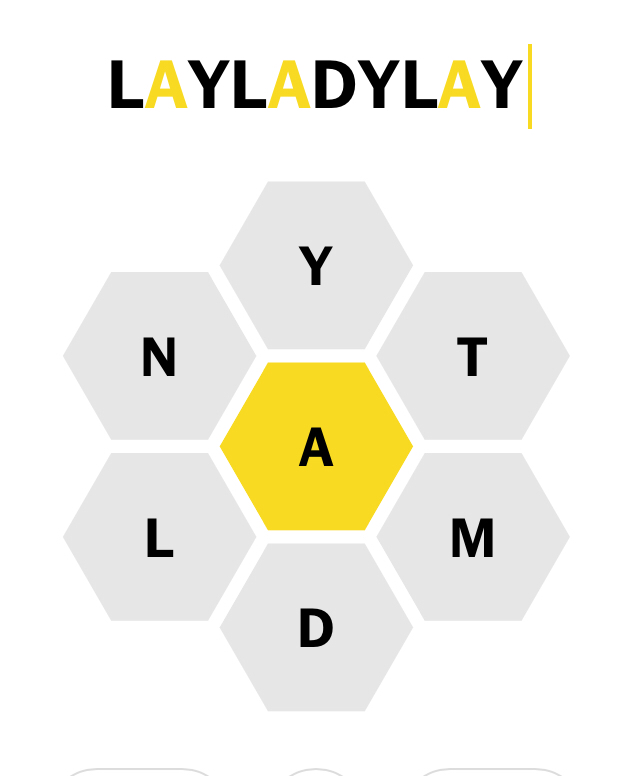
-
Mortimer, Tiger Girl
Apparently, there is a book about a cat named Mortimer, though for the life of me I can’t google it. My brother got a wee little frail cat and named it after the cat in the book, only to discover on a trip to the vet that his new cat was female. So, his Mortimer is a girl. And she is a very pretty little thing.
But Mortimer is also fierce, displaying the personality of a tiger to go with her stripes. She intimidates the dog, who is perhaps 60 pounds heavier. Another cat , Figg, came to visit for Christmas, who is much larger, but there were many spirited discussions between them about appropriate behavior, in which Mortimer held her own.
And she was so stressed by all this that any attempts to pet her were an exhibition in bi-polar behavior, rubbing the furniture to invite you in, then hissing and swiping to drive you away. It was many days before I managed to get a photo. I found her curled up at the feet of her human, late in the evening. She was comfortable enough to let me approach with my phone, but I dared not mess with the lighting, lest I break the mood.
Always take an insurance shot of the scene as you find it, from the position you are in. Only then try and get closer, add light, or do anything else to improve the photo.
-
Interruptions
I don’t know whose chalks these are, but I completely understand why they didn’t put them away. Temperatures dropped precipitously last week, from above freezing to below 0F in an afternoon. I have a full beard, a scarf, and a good hat, but the cheeks and eyes complained pretty bitterly about being left uncovered. I imagine the child (of whatever age) who left these behind had little motivation to retrieve them.
To be fair, chalk is a consumable, not a tool to be maintained for a lifetime. And as long as it stays below freezing, I don’t think the elements will hurt these much. It just raises in my the perpetual question of workspace management. For projects that take longer than one session, that need to fit in the cracks of normal scheduling, how do you manage them? Do you get another desk and set up your tools and leave them there? Do you make a new toolbox and fit in everything you need, packing and unpacking on demand?
Neither really work for me. I do better if I schedule enough time to make it all happen in one go. Unfortunately, that often means projects get delayed for long periods. It would be nice to leave everything, run inside for hot cocoa, and not come back until spring.
-
Christmas photobomb with a moral
The Christmas sermon was about how different the Christian mythology is from so many other religions. In most, god takes human form as a powerful warrior and leader. But the baby Jesus is born poor, naked and wrinkled, just like the rest of us.
This inspired today’s photo of the haves and the have-nots. Also, who doesn’t love a photobomb? If Finnegan ever takes up acting, I think he will be cast as Jabba the Hutt. He is a Maine Coon cat weighing in at 30 pounds, but he has so much fur he looks 40.
Booker, the golden retriever, was allowed inside for the opening of presents, and promptly engaged in the tradition of snagging discarded wrapping paper and refusing to give it back. The expressions that crossed his face during the tug-of-war…
A merry Christmas in the land of orange animals, which is nothing like a nativity play.
-
Christmas Eve
As many around the U.S. are experiencing a “bomb cyclone” in the days before Christmas, I thought this photo from the spring was appropriate, when the mountains got a fresh coat of snow.
Sometimes just looking at a photo like that makes me appreciate my wood stove. I have no emotional attachment to fossil fuels in machinery. Mostly, I’m glad to see them disappearing because they smell so bad. When I drive back to the cities these days, I am keenly aware of the fumes pervading the highways. But a future without cozy fires seems a little bleak to me.
Also, as a source of heat, woodstoves really excel at warming the bones and banishing the drafts. Forced hot air is rather stale in comparison. Not to mention that I love collecting all the burnable waste in the house as fuel. Tissue paper, meat scraps, bacon grease, milk cartons, all get sent to the stove to burn bright, then be returned as ash to the yard.
I grew up in the Unitarian faith, and most of their churches have a candle lighting ceremony on Christmas Eve, a living celebration of the proverb, “It is better to light a candle that to curse the darkness.” I’ll be attending one tonight and it’s always a wonderful service. Everyone gets a small candle as they enter. At the end of the service the lights are extinguished and the minister lights a candle from the main chalice. That flame is passed from seat to seat as everyone quietly sings “Silent Night”. It’s a ritual that reminds us of connection to each other, to nature, and tugs sadness out of corners and sets it free.
Fire is part of our collective consciousness, and I hope we don’t lose our connection to it.
-
Leaky Windows
Do you have modern windows, sealed tight, with multiple panes? Then you probably don’t see this when it gets very cold. But if you have a sun porch with old, leaky window, and storm windows that rattle around in their aluminum frames, then you get to see Jack Frost in action.
That first photo has traditional ice crystals, stellated like snowflakes, spreading across the glass. These always remind me of William Morris fabrics. The ice on the storm door on the front of this house has a very different pattern that forms, though I am at a loss to tell you why. It is less recognizable as ice, but more interesting for playing games of imagination.
I took this in a hurry today. I’ll go back for more tomorrow.
-
A Sourdough True Crime Story
Ladies and gentlemen: the story you are about to hear is true. Only the names have been changed to protect the innocent.
While packing to visit family for Christmas, Dufous T. Firefly decided to make his specialty bread for them. To do this, he need to bring freshly milled wheat flour and a small amount of his sourdough starter.
Dufous milled just over a kilogram of wheat berries into a ziplock bag, rolled the air out, and sealed it tightly. He took his sourdough starter from the refrigerator and used it to make two fresh starters. One he put into a clean mason jar and returned to the refrigerator, the other he put into a plastic jar with a screw top that he had bought filled with frozen pesto. The plastic wouldn’t break in the luggage, and the screw top would be strong enough to handle the pressure changes in the airplane. He put both the flour and the starter into a very large ziplock bag, rolled and sealed that one, and put it into his luggage.
His foamy sourdough starter had an interesting, earthy color, because it was created and maintained with freshly milled rye flour. This photo shows the starter with honey drizzled into it, the start of a recipe of dinner rolls.
Dufous’ trip was a long one, including a 6 hour drive to a big city, an overnight stay in a motel, and then two plane flights. Unfortunately, the first flight was delayed, so he missed the connection, requiring another night in a hotel and the last leg the next morning. When he finally arrived, he unpacked his bag and discovered the sourdough had leaked out of the jar. Fortunately, the flour was protected in its own bag, and the starter did not escape the larger ziplock.
That evening, he set about making the bread dough. He washed off the jar of sourdough, and tried to open it, but the lid would not turn. He remembered that he had screwed that lid down tight so that it wouldn’t leak, so he gave the lid a full grip and turned.
Dufous then remembered many things at once. The plastic jar was smaller than the normal jar, but he had put in the same amount of freshly fed starter that he normally made. Fresh starter expands, up to 2-3 times its original size. The longer the starter rests, the more it expands. The recommended time is 12 hours. His starter had rested for three days.
Explosive decompression is a scary thing, but at least sourdough starter is not toxic, and some warm water gets it out of a sweater. Reading glasses, dish drainers, and the sides of refrigerators are easily washed. And Dufous is quite tall, so he doesn’t need a ladder to wash the ceiling.
Dufous hopes these loaves will match the quality of his previous efforts.
-
Light, Expose
This is one of my favorite photos to show the importance of the right lighting conditions.
This was taken in July, when the sky usually has absoutely no clouds, and landscape photos are minor variations in brown and sage green. But if some clouds manage to get to the eastern edge of the Sierra Nevada and block some sunlight here and there, what a difference it makes.
Valleys suddenly appear between ridges that were indistinguishable, shadows of scrub plants add texture, everything that was flat develops depth. (Side note: “indistinguishable” is a helluva word.) There are some boulders in my valley that are only visible at certain times of the day, either when they cast big shadows or a flat face reflects light straight at me. Otherwise, I can’t make them out, even with binoculars.
Photographers always say, light is the key, but it took me ten years to understand what that meant. So, if you are starting out, work to understand that first.
-
I may write a December retrospective post on this image, but I’ll do a standard #WhatsItWednesday first.
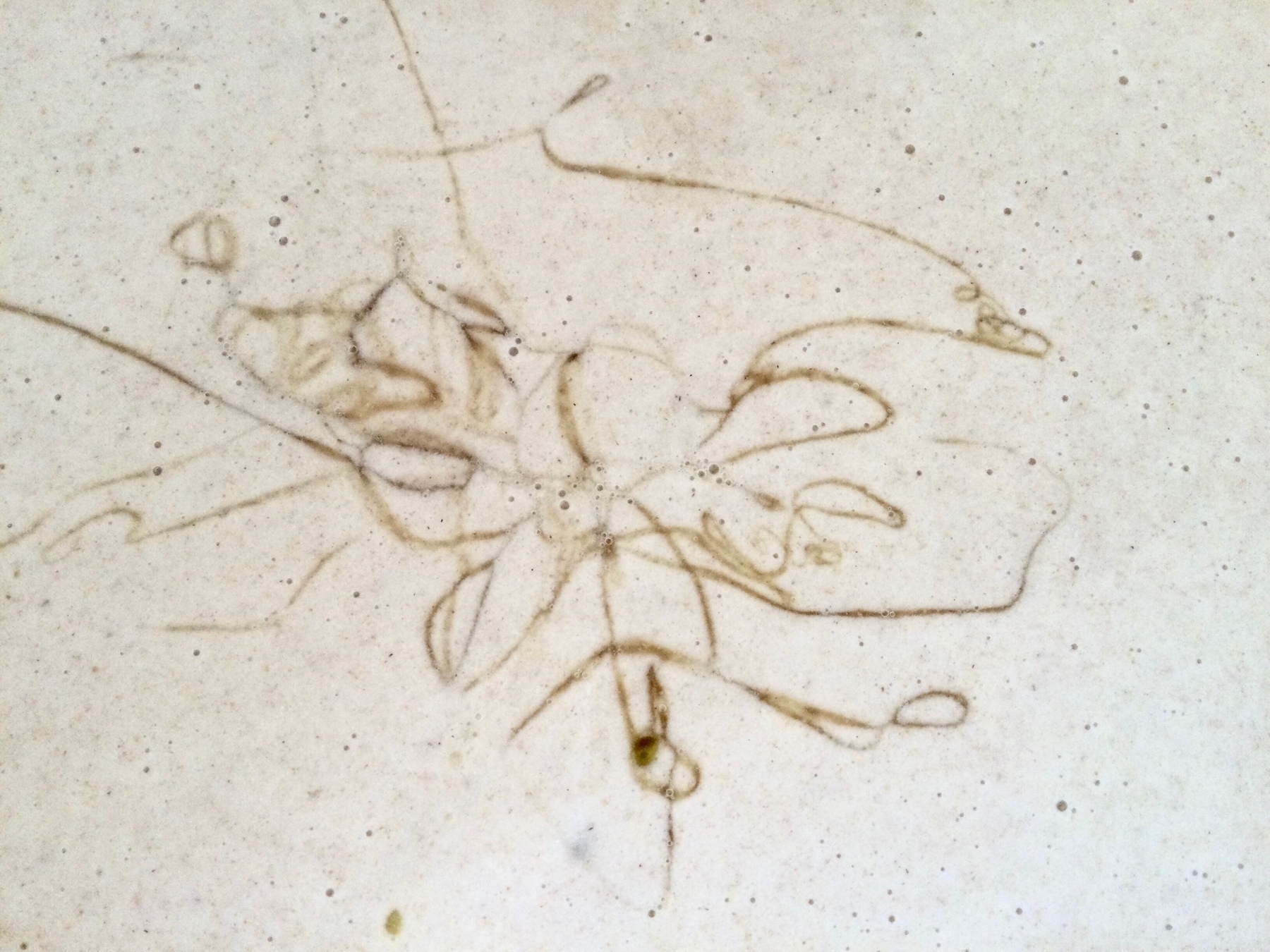
-
Mistake, Failure
Not every mistake is a failure. I had my camera set to manual exposure and took this image before I realized it. I took a bunch of other photos with the correct exposure and forgot all about this one. But when I saw it in my photo editor, I experienced an immediate sense of nostalgia., but I don’t know why.
Perhaps it is because this overexposure looks like a bad Polaroid? Maybe it triggered some deep memory? Regardless, I like the minimalism of this image. It brings a different train of thought than the properly exposed images, and I find myself returning to it.
Discoveries like this are part of why I avoid rules of photography. I prefer to explore each parameter from end to end, to understand how it changes the image and discover what effect it may have on me and others.
-
Fall, Granite
Cottonwood trees in fall colors really make Wheeler Crest look its best, I think. This granite ridge is impressive when you can see the whole thing, but I find it even more amazing when I can only see part of it.
Wheeler Crest is so big, its scale is hard to understand. The section in this image is less than half the vertical span of the front range, and yet the base is almost three miles from where I took the photo. You can just see a bit of the next ridge back at the upper left. All told, the crest rises about a mile and a half from the valley floor.
I once knew a fellow who cycled 300 miles in three days. His wife travelled in parallel by car with their kids, so all he carried was a spare tire and a credit card. For lunch on the second day, he stopped at a rural diner and ordered two of everything, and the two young waitresses on duty were very intrigued. He told them where he was riding from and to, places they’d heard of but never been, and they were impressed. Then he said he’d started that morning from a town to the south, a place the waitresses had been many times because it had the nearest mall, and they were blown away. The longer distance was abstract and easily dismissed; the shorter distance was far more impressive to them because they had travelled it themselves, and it was nearly an hour by car.
Looking at this photo and thinking of that story, I’m more understanding of their amazement than I used to be.
-
Close, Moon
Robert Capa said, “If your photographs aren’t good enough, you’re not close enough.” But how do you get close to the moon? Join NASA or buy a bigger lens. I wouldn’t mind joining the space race, if I could find the right niche, and I have a big enough lens to photograph the moon in good detail. But, and it’s the darndest thing, close up, the moon always looks pretty much the same.
Photos of the moon taken terrestrially rely on composition and context to be effective, but also have surprising exposure challenges. How bright is the moon? If you point your camera straight at it, what should you set your camera exposure to? If you look up the answer, I bet you’ll be surprised.
[Exposure Value]((https://en.wikipedia.org/wiki/Exposure_value) is a scale of brightness, useful in determining camera exposure settings (f-stop and shutter speed) for different scenes and lighting conditions. The brighter the scene, the larger the EV, and 1 EV is one stop. Snow in full sun: EV 16; Christmas tree lights: EV 4; stars and the like are all negative values.
Scenes lit by the full moon are roughly EV -2. But if you look directly at the full moon? EV 15, nearly as bright as full daylight. Given that a single image might have a dynamic range of 6 EV. trying to capture a range of 17 EV means having both the moon and the moonlit scene requires special measures.
One solution is to photograph the moon in the sky with clouds that are still brightly lit, which is what I did above. I have zoomed in shots, but I like this wide shot better. Sorry, Mr. Capa. This is why I warn about photographic “rules”. They aren’t worthless, but they can be constricting. Sometimes, the most interesting photo is the one that steps outside the rules.
-
Borrowed Cats, #Caturday
Well, it’s time to celebrate #Caturday again. These two villains live next door, and I get to borrow them when their people foresake them. This is Greybear, the supermodel. It’s not just his visage, he has the personality to match. He needs to be cuddled like a baby on your shoulder (always the left one) and he has quite the vocabulary around summoning food. But he will also pose for the camera, staying in one place for 20 minutes at a time, but changing position and expression at just the right pace. A single photo shoot with Greybear could fill a magazine.
He’s not all cuteness, either. He’s got attitude and brings it to the runway, like any good supermodel.
Diego, the Dark Lord of Destruction, is the black one, and takes a different approach to life. He has two methods of getting attention: lie on the most vital and/or vulnerable piece of equipment on my desk; play increasingly aggressively with the lowest pieces of a huge stack of papers. He actually asks very politely for attention first, but if you’re busy, you’ll miss it. He looks evil, especially with eyes lit up, but he never uses his claws in anger. However, I did once make the mistake of tickling the corner of a cardboard box with my bare finger while he was inside. The blood loss was significant, but we agreed the injury was my own fault. I always use a stick now, at least a foot long.
The first few times they fell under my care, I visited them in their home, but that always left them starved for attention and me wracked with guilt. So we switched to bringing them over to my place, and that turned out to be a winner. They complained a bit the first time, but by the third or fourth, they knew what to expect. Mind you, they prefer being home with their people, which they make quite clear by running into their respective carrying cases when it is time to go home. Sometimes they get so excited, they squeeze into the same one.
And I like having them visit, because it is rather like what grandparents say: I’m happy to have them come stay, and happy to see them go home.
-
Snow Shadow
Wheeler Crest during a recent snowstorm.
I mentioned that we rarely have a blanket of clouds, but we did get a snowstorm recently where the cloud cover came and stayed for a couple of days. We got some lovely snow, but there’s no light peeking in for dramatic photos. What’s left in this case is a reduction of elements, featureless clouds, snowy mountains, and the desert chaparral.
I decided to look up “chaparral”, since the word keeps occurring to me, but nobody here uses it. The definition seems flexible, covering desert scrubland in several different locations, from Oregon to Mexico. The Wikipedia article says the vegetation here is California transmontane (desert) chaparral. Rolls off the tongue, doesn’t it? Maybe that’s why nobody uses the term here. They talk instead about the Great Basin Sage and Antelope Bitterbrush, two of the plants that dominate in this harsh envionment.
In the absence of light, my eye turns to geometry. Somehow, these wedges of the world capture this snow shadow realm very nicely: so much snow, but none makes it down to the chaparral.
-
Clouds, Humility
Yes, that says “humility”, not “humidity”. I’ve been writing about clouds in this December Retrospective with ease and confidence, as if I really know what’s going on. Then we get to a formation like this and I have to pony up that I have no clue about this one.
That’s a good thing. We can’t be experts on all things and it’s good to be reminded of that. In graduate school, I had a moment in the engineering library where I grasped how much I would never get to read. It was a small library, relatively speaking, and the section I frequented was so cutting edge it barely had any content, yet there was still too much to wade through. Where I was standing I could see the ends of all the aisles, and I realized I couldn’t even think of enough disciplines to assign to those aisles, much less absorb what was in all of them.
As a group, humanity understands a great deal; individually, each of us should remember we have limits.
Here’s a closeup of the same formation, taken ten minutes later.
Maybe those are mammatus formations dotting the underside, so called because they look like breasts. But I forget how and why those form. I think I’m actually more confused about what is happening when looking at this second photo. Unlike the Sierra Wave, which shows up regularly, this is the only storm like this that I have seen. I hope it shows up again. I might have more ideas next time.
-
Thoughts on #WhatsItWednesday
This year I’ve borrowed an idea from @dejus, a regular visual puzzle posted on Wednesday, dubbed #WhatsItWednesday. Here is my photo for this week.
My version of this game is slightly different than @dejus’, in that his normally has a clear photo of a manufactured object, usually a small part of a larger machine or product which is very recognizable. That’s a fun game, but the puzzles I come up with have a different flavor, generally stemming from physical processes, such as ice freezing. However, obfuscation by narrowing the focus to remove context is a fundamental trick that I use as well. The name also doesn’t quite suit me, so next year I will probably “re-brand” to #VisualPuzzle.
Interestingly, none of my puzzle photos have been landscapes: they are just too recognizable, even when you zoom way in on something. The only photos I know of that could qualify are drone shots, where a pattern we don’t normally see can be hard to place.
I’ve valued the #WhatsItWednesday meme because it makes me look for abstractions in small things. I love the clouds and landscapes, and they are popular with my audience, but having a regular alternative goal acts as a palette cleanser.
The most difficult part of this game is gauging how difficult a photo will be to recognize. Ideally, I’d like to find a “Goldilocks” zone, where nobody gets it at first, but a few hints brings recognition. Alas, Papa and Mama bear dominate.
That said, I think today’s puzzle is going to be easy for people, so I’m providing second one that I figure will be impossible.
-
Roadrunner, Owens Valley
A roadrunner sits on an old, burned fencepost in Owens Valley.
Funny thing about the Greater Roadrunner, their range stops right where I live. Any further north and the increase in altitude brings changes in climate that apparently don’t suit them. They come up the Owens Valley, a long channel running north to south between high mountain ranges. The valley has water, plenty of wildlife, and little snow.
After I noticed the range map, I looked up what it eats. Wikipedia says they are opportunistic omnivores:
Its diet normally consists of insects (such as grasshoppers, crickets, caterpillars, and beetles), small reptiles (such as lizards and snakes, including rattlesnakes), rodents and other small mammals, spiders (including tarantulas), scorpions, centipedes, snails, small birds (and nestlings), eggs, and fruits and seeds like those from prickly pear cactuses and sumacs.
Dang. Smash and grab artists. Warner Bros. made them seem so nice.
Well, we certainly have plenty of lizards here, but I guess they peter out to the north. I wonder if they eat wood rats? One of those little fiends moved into my car and did a lot of damage. I’d love to see a roadrunner skewer one of them.
-
Rain Shadow, The Other Great Divide
Normally, a great divide is a drainage divide, the peak of a mountain range where water on either side flows into different drainages. In the Eastern Sierra Nevada, the prominent feature is the divide between mountains and high desert, a change in climate known as a rain shadow.
The predominant winds are from the west, bring warm and wet ocean air. As that air is forced up and over the high peaks, it cools and condenses the moisture into rain or snow. If there is any moisture left as it makes its descent, it runs into the hot, dry air of the Great Basin and Range, which stretches from here to western Colorado.
Basin and Range. It sounds musical. To geologists, it has specific meanings that I wasn’t aware of until I lived here. Geographically, a basin is a valley with no outflow. Mostly, these form lakes, but in the rain shadow, they are just sandy valleys, mostly devoid of water. The mountain ranges that separate the basins are raw rock, layered, tilted, barren.
The high Sierra is barren in its own way, freshly cut granite with little soil, but the altitude and water make for a wildly different environment.
This photo shows the divide. Snow and evergreens above. Great basin sage and bitterbrush below.
-
Clouds, Mountain huggers
I’ve talked about cloud layers and lenticular clouds, but there is another formation here that I love: mountain huggers. I know, I go a little overboard with the technical meteorological terms, sorry.
Here is Mt Tom with clouds flowing down the eastern face. Weather comes from the west and spills over the high peaks. Mostly, the valley is full of hot air that dissipates all the moisture. In this case, there’s enough to make it to the valley floor, but just barely. Sometimes the mountain huggers float horizontally in long streams, buoyed by the hot air below.
This is another answer to the question, “Do we have fog?” Yes, we do, and wheneve it rains enough (which is seldom), we can see it in the distance on the mountains. Oddly, unlike a London fog, these clouds don’t hide detail as much as they reveal it.
Those granite ridges are hard to distinguish from each other when they are bare, especially from fifteen miles away. With the fog sliding down the canyons between them, the ridgelines stand out as separate entities. I noticed this when I saw one more ridge than I thought there would be. That area is really hard to explore, because it’s a long drive up a rocky road followed by extensive hiking, and I don’t have a clear idea of where each of those canyons emerge.
The whole weather system changes the appearance of the mountain entirely. Since I can’t see the peak, and the base looks completely different than usual, I wasn’t sure, looking back through the year’s photos, that this was actually Mt Tom. I had to study the foothills and the details of the valley floor to be sure. Fog from a distance is different than when you are in it, but it still changes the way you see the world.
-
Lenticular, Sierra Wave
Persistent stable clouds form in the Sierra Wave.
Winds form standing waves over the mountains here, just as flowing water does over rocks. Dubbed the “Sierra Wave”, these formations give themselves away with pressure changes, which condense moisture into clouds. These clouds are often “lenticular”, meaning they are shaped like lenses. I suppose a physicist might say the bending of the air is in fact a lensing effect. Water isn’t compressible, so we don’t see a similar effect in streams.
The curious thing about lenticular clouds is that they don’t float by. Cumulonimbus floating over the plains move with the currents, so the sky is ever changing. Lenticular clouds change shape slowly over time, but are mostly stationary, an integral part of their environment. The formation in this photo lasted for several hours.
Our lenticular clouds are often layered, like fine pastry, but I don’t know why. I do know that the edges catch light and add contrast to photographs, so the clouds don’t just appear as blobs. Lenticulars are also very smooth, not bumpy like cumulonimbus, nor wispy like cirrus. This makes them a real puzzle for autofocus algorithms. Often I will look at a shot in post-production and think it out of focus, only to look down at the mountains and see they are sharp and crisp.
Lenticular clouds are fascinating to watch because I like to think about the physics of their creation, but since they have a very defined and stable form, they don’t lend themselves to the cloud shape game.
-
Sunset, Beauty Call
Sunset over the shoulder of Wheeler Crest.
Clouds are a big part of the show here, and they’ve been especially vibrant and varied this year. That’s been convenient for my daily photo blog, because I’ve also been chained to my desk a lot. But it makes for a lazy compromise: one of the points of keeping a posting schedule is to get out and explore the world, and that’s easy to do when amazing things are just sliding by.
We get a wild variety of cloud forms here, due to the rugged terrain, the change in altitude, and the change in climate. Wind is funnelled and shaped by the canyons in the high Sierra, then shocked by the hot dry air of the desert.
But what we rarely see is a sheet of low-hanging gray that covers several states and persists for days, like I grew up with on the east coast of the U.S. Here, those blankets get chopped up by the underlying peaks and valleys, so It seems like there’s always a gap where light gets through. All that combined creates scenes like this, where sunset can get underneath the chassis and light it up. Add in a dramatic ridgeline, and there’s almost always a photo to be had on a busy day.
And it doesn’t seem to matter who you are, young or old, retired or not, everyone gets absorbed in what they are doing and misses parts of the big show. That’s why we help each other out by texting “beauty calls” to each other, an alert to go outside and watch cloud porn.
subscribe via RSS
